| ILFORD Chronology |
|
|
|
|
| Ilford Chronology: | |
|
The original basis for the following 'Ilford chronology' was the Ilford Imaging (before ILFORD Photo) web site, but I have expanded that source considerably and am constantly adding to it through my own research and the contributions of the many people who e-mail me. Information relating to 'CIL' products emanating from Ciba Lumière (see the entry for 1963, below) come from Andy Holliman (whose further contribution can be seen on the Sportsman History page). I'm also indebted to Martin Reed (previously of SilverPrint, now importing Foma film, paper and chemicals) who provided me with some of the facts relating to the years 1975 thr' 1999 which I have incorporated into my own. Items marked (Ref: D.M) have been provided to me by Doug McKee. Some of the booklets and leaflets that are illustrated belong to David Muggleton; others belong to Paul Godfrey who has been generous in sharing his items, often backed-up by information based upon his professional experiences. There is always uncertainty about the accuracy of historical information so do e-mail if you can improve on the information contained in any of my web pages. A list of many Ilford plates, flat film and roll film can be found in the book 'Silver by the Ton - A History of Ilford Limited 1879-1979' by RJ Hercock and GA Jones, two distinguished Ilford employees. The publishers are McGraw-Hill Book Co (UK) Ltd, Shoppenhangers Rd, Maidenhead, Berks, SL6 2QL; 176 pages illustrated in black & white. The ISBN is 0-07-084525-5. In August 1979 it was priced at £9.95 in hardback. To view some early ILFORD
plate (and process plate) packaging, click here. ILFORD Photo's own chronology can be viewed here. |
|
|
Alfred
Hugh Harman begins making Gelatine Dry Plates in the basement
of his house in Cranbrook Road, Ilford, Essex. His business was named 'Britannia Works'. |
||
|
|
The business expands to houses purchased in Grove Terrace (later Uphall Road, Ilford). | ||
|
|
New factory built
adjacent Grove Terrace on a site that would subsequently have
the address of Roden Street (maybe called Roding Street at the
time) and become the premises of Ilford, Ltd. In 1883 Harman introduced the paddle steamer trade mark |
||
|
|
Introduction of Bromide & 'ALPHA' paper | ||
|
|
Introduction of 'ORDINARY' Plate (4.5ASA) | ||
|
|
Britannia
Works is now Britannia Works Co. Prices of dry plates reduced to penalise the Marion plate company after a dispute with them. Renaming of products to 'Ilford' Dry Plates "known prior to February 1886 as 'Britannia'." |
||
|
|
Doug Mckee has copies from No.35, July 1893 to No.50, October 1893. He also has a copy dated March 1899. The July 1893 issue No.47 shown alongside has the foreword "The monthly issue is now over 29,000 and copies can be had from photographic stock dealers throughout the world, from China to Peru. Any dealer who does not get a sufficient supply, should drop us a postcard stating his wants." By June 1908, the circulation had reached 40,000 monthly, see bottom of p8 of the pdf here. A web page devoted to 'Photographic Scraps', where copies can be downloaded as pdf files, is available by clicking here. "Photographic Scraps" ceased publication in 1914 and didn't restart after World War 1. |
||
| Ilford Alpha Lantern Plates, box image see here. | |||
|
|
'The Ilford Manual of Photography', originally
'The Manual of Photography', was first published in 1890. Mr
C H Bothamley was the principal writer of the the Manual and
it was published by the Britannia Works Co. (which became the
Britannia Works Co., Limited in December 1891). The Ilford Manual
of Photography continued in production to a 5th edition in 1958
(see below) which was reprinted eight times to 1968. Thereafter
it was taken over by the Focal Press and its title reverted to
simply "The Manual of Photography". The book reached
its 10th Edition in 2011 published by Taylor & Francis (my
thanks to Gavin Ritchie for this information) Despite the use of Ilford's name in the title of the earlier editions, it was not dedicated to describing the use of ilford equipment and chemicals, but was a generic description of how to use cameras, process film and make prints. |
||
|
|
The company (still privately owned) was registered as 'Britannia Works Co. Ltd' on 17th December. First Board Meeting was held on 2nd December. George Eastman (of Kodak fame in the USA) first set up business in the UK in 1885, as the "Eastman Photographic Materials Company, Limited", a wholesale importing company. They began manufacturing photographic materials (film and printing papers) in Harrow, Middlesex, UK around mid-1891, becoming future competitors to the Britannia Works Co. and Ilford. Subsequently, "Kodak, Limited" was formed in November 1898 when they acquired the business of the Eastman Photographic Materials Company, Limited. Kodak's Managing Director was Mr.William H. Walker. Introduction of Printing Out Paper; P.O.P., see here. |
||
|
|
In 'Photographic Scraps' for
1st August 1892, there is an announcement of 'The ILFORD Year
Book, Diary, and Register of Exposures'. Ron May owns an 1895 copy of
'The ILFORD Year Book' (the title seems to have been abbreviated
since the 1892 announcement, above) and has provided scans of
its cover and a few of its 180 pages. To view these, click
here. |
||
|
|
Introduction of SPECIAL RAPID (13ASA) Plates, see here. Introduction of PROCESS (0.55ASA) Plates. |
||
|
|
In 1897 and again in 1903, Eastman Kodak approached the company with a view to a take-over or an amalgamation, but nothing came of these proposals. Bromide Platinomatt Surface paper – (‘PMS’ paper) introduced. See packet cover image alongside, courtesy of Michael Talbert. See here. |
||
|
|
10th March; meeting
to discuss going public. 17th May; first Board meeting of The Britannia Works Co.(1898), Ltd. 7th June; Extraordinary General Meeting (EGM) held. A vote re: 'Going Public' was put to shareholders and 'carried'. 19th July; The name of The Britannia Works Company (1898), Limited changed to The Britannia Works Company, Limited The reference to 1898 in the company title was soon dropped (Companies House shows 10th August 1898; my thanks to Gavin Ritchie for this information). 14th Sept; the (private) company 'Britannia Works Co.Ltd ceased to exist and the (public) 'Britannia Works Co.(1898) Ltd. came into being with a nominal share capital of £380,000. Alfred Harman (then aged 50) retired from active control of the company at that time but continued to provide his expertise and experience for several more years. |
||
|
|
Platona printing
paper introduced. Still in production in 1908. See pdf of a Platona instruction leaflet here. A Platona 'ILFORD Platinum Paper' tin, used by the Britannia Works Co. Ltd, Iford, London, for the supply of Platona paper around 1899. This tin measure some 170mm in length and 65mm diameter. The lid has an air tight seal ring which seals against the body of the tin when the lid is securely screwed on. The paper has to retain a trace of moisture in order for the development process to work, so presumably the air-tight lid prevented the paper from completely drying out. To see closer views of this tin, plus a smaller tin (in better condition), click on the image alongside or here. |
||
|
|
In October, the
company made representations to change their name to Ilford Ltd,
but the Ilford Urban District Council objected. The Ilford Urban District Council finally approved the name change from Britannia Works Co. Ltd. to 'Ilford Ltd' provided there was a comma inserted after the name 'Ilford' and Ltd was spelt in full i.e. Ilford, Limited. (The change of name to Ilford, Limited was finally registered on 24th December 1900; my thanks to Gavin Ritchie for this information). The comma continued in use, officially at least, until 1951 (maybe there was a 50year agreement with the Council?) but in practice it was dropped from advertising literature around 1935 (possibly the result of the area becoming the 'Municipal Borough of Ilford' in 1933 ?). (Ref: D.M) |
||
|
|
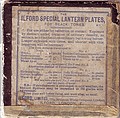 A box of Ilford Special Lantern Plates, photographed by Rab Egerton. Click here, or on the image to see an enlarged view. The box is marked H1 = August 1901. |
||
|
|
The 1903 & 1904 BJPA gives the price of the camera as £5 with the Bausch & Lomb Rapid Rectilinear f8 lens in Unicum Shutter (T,B, 1-1/100s; as in the NMSI collection) or £8.8s (£8.40p) for the Ross Symmetric Anastigmat lens in Lopa Shutter. Ilford Special Rapid Films, in boxes of 20, cost 3s/4d (16.5p) postage extra. A camera price of £5 is equivalent to around £620 in 2020 money, based upon a comparison from this site (thanks to Gavin Ritchie) http://www.thisismoney.co.uk/money/bills/article-1633409/Historic-inflation-calculator-value-money-changed-1900.html |
||
|
|
Ilford 'MONARCH' Plate (3.5ASA ~ or maybe 35ASA as is stated in "Silver by the Ton" for Monarch Flat Film introduced in 1906). | ||
|
|
Ilford X-Ray Plate | ||
|
|
The 'Photographic Scraps' monthly news sheet (now "post free for 12 months for 6d" - 2.5p) which started in August 1889 (see above) was still in circulation and had reached a monthly circulation of 40,000, see bottom half of p8 of the pdf here. It finally ceased publication in 1914. See pdf here for a 1908 (F.8) leaflet that includes Platona, Bromide paper & rolls of the time, Plates & films, Kalona self-toning paper, GasLight paper, P.O.P, Bromona & announcement of the 205th thousandth Ilford Manual of Photography. |
||
|
|
Ilford 'KING'S OWN' Plate (20ASA) | ||
|
|
Alfred Hugh Harman died in the 2nd quarter of 1913. The death was registered in the district of Hambledon (which spans the boundaries of the counties of Surrey and Sussex) and appears in the General Register Office (GRO) Index as Page 211, Volume 2a. | ||
|
|
Information from
Harman Technology, emailed to me by Brett Killington, is that the following 19
Ilford employees lost their lives serving their country during
the 1st World War. "Age shall not weary them, nor the years condemn". H.G.Bailey; T.Bell ; H.W.Bones; W.W.J.Christmas; J. Cook; J.A.Cornish; J.T.Cornwell (V.C); F.J.Coyle; A.W.Dyson; R.T.Elliott; H.Green; H.Hickmott; J.Hyde; W.Knight; B.C.Munday; F.E.Savill; H.C.Trow; A.H.White; W.Wright. |
||
|
|
Ilford daylight loading Roll Film first introduced | ||
|
|
 Ilford Special Rapid Panchromatic Plates (16ASA at the time but equivalent to 32ASA in the rating system post-1960). The pack illustrated holds 1 dozen (12) 5" by 4" plates. Sensitive to all colours, the plates needed to be handled & processed in total darkness. For a close view of the box (left) and of the processsing instructions on the back of a March 1926 pack (C 26), click on the image or here. The scan of the instructions was emailed by "David". |
||
|
Imperial was already under Ilford
Limited influence by 1919, and was possibly already owned by
Ilford Ltd. (see the chronology 1928-1930 'slot' below). Paul
tells me, based upon information from the book "Silver By
The Ton" (see text under 'Ilford Chronology' above), that
Imperial produced one of these books each year until 1927. However,
Richard W Holzman has e-mailed (March 2020) with the news that
he has acquired a collection of Imperial Handbooks spanning 1914-1934
(though missing the 1915 & 1922 issue). The 1934 issue was
the 40th edition and (despite the 1927 date in Silver by the
Ton) this edition is believed to actually be the last. Since
this was the 40th edition, the publication must have spanned
1894-1934. Content relating to Selo roll films increased 'year
on year' in the 1930s until, by 1934, all the adverts related
to roll film. |
|||
|
|
The 'Selo' company was
formed with the purpose of carrying out the joint R&D and
sensitising of roll films, for all of the companies now falling
under the Ilford company "umbrella". Ilford at this
time imported its film base material, first from the Celluloid
Corporation (USA) and later from Gevaert (Belgium). Selo films were sold by these companies under their own labels. The 'Selo' company was situated in Woodman Road, Warley, Brentwood, Essex. Although the name 'Selo' was officially dropped in 1946 (see below) the Brentwood factory continued to be known as 'The Selo Factory' until it was sold and the site subsequently levelled in the early 1980s. Sharon Ellis has sent
me a picture showing her Great Uncle, James Charles Emberson,
as a member of a 'gang' of workers constructing (or extending)
the Selo Factory in May 1921. |
||
|
|
Edwin Garcia (in May 2009) pointed out that Kodak's D-76 and Ilford's ID-11 are identical formulations, and that D-76 was devised by a gentleman named Capstaff in 1926. Ian Grant has supplied a link, which suggests that D-76 was originally a motion picture developer and appeared at a slightly later date than Edwin Garcia mentions, perhaps 1927-28. Ian Grant tells me that Kodak's D-76 formula began with a body of research based upon the Wellington Fine Grain M.Q. Borax developer, as appears in the 1922 Wellington Photographic Hand Book, though may well have been available much earlier. Kodak's own research eventually led them to D-76. By the time Wellington & Ward (W&W) were taken over by Ilford around 1930, Wellington was aged 71 & his brother-in-law Ward was probably of similar age. Wellington had been a manager within Kodak for a short time before setting up W&W in 1895. A February 1934 booklet "Ilford Plates and Films" (see below) has no mention of the ID-11 formula, and doesn't use the ID naming system. On the other hand, a January 1937 booklet entitled "Ilford Book of Formulae" (see below) does use the ID naming system and provides the formulae for both ID-2 and ID-11. Hence it seems the ID naming system was introduced between 1934 and the end of 1936. The 1934 booklet states an identical formula to ID-2, but refers to it as simply Metol-Hydroquinone. Since there is no equivalent ID-11 formula in the 1934 booklet, it seems neither ID-11, nor any developer of that formulation, was recommended by Ilford until sometime post-1934, confirming that Kodak's D-76 pre-dates ID-11 by at least 7 years. Further information from Ian Grant is that Kodak eventually published their D-76 formula, and it became the basis of not only ID-11 but also Dupont/Defender 6, M&B 320, Forte FD20, Foma FV5, Agfa 19 and Gevaert 206. |
||
| Ilford Cinematograph Film first distributed. | |||
|
|
Ilford 'UNIVERSAL'
Film. In June, George Herbert Leigh Mallory of Mobberley, Cheshire (subsequently home to ILFORD Imaging UK and now ILFORD Photo), and Andrew "Sandy" Irvine, set out to conquer Everest. Both men were lost and it remains a mystery whether they reached the summit. |
||
|
|
First attempt at manufacturing a subtractive type of negative-positive colour 'tri-pak' roll film in conjunction with a small concern called Colour Snaps (1928) Ltd. The film was called Colorsnap film. The process proved difficult and was wound up in 1930. | ||
|
Introduction of Ilford Soft Graduation Panchromatic Plates, 28ASA - would have been 56ASA in 1960 revision - reflected in the plates having an Ilford speed rating Group E. To see a close up of a similar box image, plus others provided by Simon Spaans, click on the images or here. |
|||
| Ilford Ultra-rapid Roll Film, 28ASA. | |||
|
to 1930 |
Ilford acquired the Mobberley
site (owned by Rajar
Ltd since 1903), in the take-over of the various companies
within the Selo organisation formed in 1920. APM, a part of Selo
from 1921, was split and a new organisation formed, called APeM
(Amalgamated Photographic Equipment Manufacturers ). APeM subsequently
(maybe by 1929) became part of Ilford, consisting of Rotary Photographic
Co Ltd; Rajar Ltd; Paget Prize
Plate Co. Ltd (see picture, courtesy of John Wyllie), and
Marion & Co Ltd. The other part of APM (camera manufacturers
Kershaw Optical Co Ltd; A Kershaw & Son Ltd. and Marion &
Foulgar Ltd) became Soho Ltd. |
||
|
Wellington & Ward (based at Elstree, near London) joined Ilford by 1930. Ilford had already (by 1920) some commercial involvement with other old-established UK photographic businesses, viz: The Imperial Dry Plate Co.Ltd; Thomas Illingworth & Co.Ltd and The Gem Dry Plate Co.Ltd, but possibly the merger with APeM lead to Ilford exercising more direct control over all these previously small independents. Click on the above links to see some original advertising logos used by these companies. Some of the scans by courtesy of an email correspondent "David". The BJPA orbituary for James B.B.Wellington can be seen at the end of the 1939 'slot', below. Jessica Trethowan's grandfather,
Henry Phillips, worked in the laboratory at Thomas Illingworth's
premises in Cumberland Avenue, Park Royal, London NW10. Quoting from a Supplement to
'Ilford News' Series 1, Number 6 (see 1939 below) "The
effect of this great merger was a unique pooling of experience,
knowledge and craftsmanship. The best brains of the companies
concerned became at once concentrated in the research and production
of one company's products, with the result that many important
new products were produced and improvements effected in various
existing grades". Between 1918 and 1939 Ilford acquired directly or through subsidiaries some dozen businesses engaged in the manufacture of photographic goods of various descriptions. During the 1930s a number of distribution centres were set up in different parts of the country and factories or branches were established in five European countries and in India and Australia. During the next 30 years, Ilford's Mobberley site began to concentrate on the manufacture of photographic paper. The large rolls of paper were transported to the Essex factory for cutting, packing and distribution. |
|||
|
|
Interestingly, there is no mention of Selo products at this time. Ilford roll film is still named, simply, Ilford Roll Film, speed H&D350 suitable for "Snapshots, all subjects all weathers." The H&D350 speed is equivalent to around 25ASA (ISO) on the post-1960 rating basis. The marketing name Selo, for roll films, must have first appeared in 1930 (for confirmation, see below). |
||
|
|
"The SELO soldier will 'Fire his First Shot' on April 8th. It will be one of great power and range - a whole page announcement in the Daily Mail. Issue your orders now! Be certain that you will have the 'SELO' soldier saluting in your windows when the great campaign opens". By being a joint product of previously independent film suppliers viz: IMPERIAL, ILFORD, ILLINGWORTH, RAJAR (Apem, Ltd.), GEM and WELLINGTON, the single SELO Film product, distributed by all these companies, promised to simplify the handling of stocks by High St chemists i.e. one film from all six suppliers rather than different films from each. By the 17th May 1930 issue, within the pages of The Chemist and Druggist magazine, Ilford were notifying chemist shops of the availability of eye catching display materials to attract public attention and assist the sales drive for Ilford Selo film. To see some Ilford advertisements at that time, plus a very early SELO 127 size roll film, and magazine descriptions of visits to the SELO factory, click here and scroll down. |
||
|
The Selo company had effectively already come under Ilford control by 1925 but the name 'Selo' was not adopted by Ilford as their film brand name until 1930 (see above). Once in use, the name Selo survived in the film name 'Selochrome' until around 1968. Click here, or the advert alongside, to see how Selo film was being advertised in Amateur Phographer magazine in September 1930. The 1930 AP advert shows that Ilford size No.20 'Selo' film cost 1/- for 8 exposures. |
|||
| Ilford Panchromatic Film (32ASA) introduced. | |||
|
lford's advert suggests "Still
Time for Daylight Printing - Finish off those Summer Prints with
INTONA, the Ilford Self-Toning P.O.P (printing out paper). It
prints right out so that progress may be watched. The paper with
the minimum trouble and the most artistic results. Tones ranging
from beautiful browns to photographic purple, obtained at will
with Hypo (fixer) only. No other chemical required." |
|||
|
This roll was presumably exported to the continent as it's labelled "Importe d'Angleterre" (French for "Made in England"). Image from Charlie Kamerman. |
|||
|
|
Debut of Hypersensitive Panchromatic (initially for Plates), later to become known as HP (as in HP3 etc) | ||
This booklet has been made available by Gavin Ritchie. It was issued by Ilford to coincide it with being 12 months from the first commercialisation of Selo roll film on 8th April 1930 (see above). The opening reads: The Triumph of Selo Film "This booklet forms the second chapter in the history of the Selo Film. Its predecessor, "The Story of the Selo Film," written just before the film was placed on the market, was chapter one. Although twelve months only have elapsed, the Selo Film has become an established success, in fact a phenomenal success, for never before within such a short period has any roll film achieved such enormous popularity". At the end it reads: "Watch for the Selo Soldier in dealers' windows, on the walls, and in the newspapers, and let every Selo Soldier remind you to load up with Selo Films for successful snapshots. Remember the name SELO". |
|||
|
|
Ilford Infra-Red Plate | ||
| An entry in the
1937-38 Motion Picture Almanac:: Richard S Liddle joined the photographic industry as a salesman of celluloid base and became a Salesman for Selo Film Stock in 1928 and joined Ilford Ltd in 1932. By 1937 he was London Sales Manager within Ilford's Cinematograph Department. |
|||
| Selochrome, a higher
speed version of the original SELO film, was marketed. Selochrome
was around 100ASA, compared to 64ASA for the original SELO(chrome)
film. These speeds are relative to post-1960 speed ratings. See a 1934 advertisement in Amateur Photographer magazine for the new Selochrome and also read the Lidy Haremaker story, immediately below. |
|||
|
|
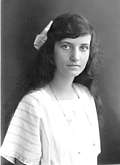 An
interesting e-mail (August 2005) from Frank Philipse in the Netherlands, gives
extracts from the diary of his relative, Lidy Haremaker (1905-1984),
who became a teacher of English in the Netherlands. Lidy was
Dutch and lived in the Hague, but she visited Ilford's Selo factory
in early 1933 while on a trip to London. Lidy was an intelligent
women with broad interests, including photography. On Saturday
7th January she writes "I wandered a little about Mansion
House and came into Cheapside where are many shops, and I saw
the newest kind of film to make photographs in the evening."
She visited the "factory in Brentwood, which the Ilford
people had arranged for me. I had rung up Mr Davidson,
manager of Selo Ltd. - Woodman Road - Warley - Brentwood,
Essex (tel. 631)." Lidy visited Selo on Thursday 12th
January 1933 ,"I was back in London by three and went
to Cheapside to buy the new kind of film." Lidy
is clearly referring to a higher speed film than had previously
been available. An
interesting e-mail (August 2005) from Frank Philipse in the Netherlands, gives
extracts from the diary of his relative, Lidy Haremaker (1905-1984),
who became a teacher of English in the Netherlands. Lidy was
Dutch and lived in the Hague, but she visited Ilford's Selo factory
in early 1933 while on a trip to London. Lidy was an intelligent
women with broad interests, including photography. On Saturday
7th January she writes "I wandered a little about Mansion
House and came into Cheapside where are many shops, and I saw
the newest kind of film to make photographs in the evening."
She visited the "factory in Brentwood, which the Ilford
people had arranged for me. I had rung up Mr Davidson,
manager of Selo Ltd. - Woodman Road - Warley - Brentwood,
Essex (tel. 631)." Lidy visited Selo on Thursday 12th
January 1933 ,"I was back in London by three and went
to Cheapside to buy the new kind of film." Lidy
is clearly referring to a higher speed film than had previously
been available.An entry in the book 'Silver by the Ton' on page 119, describes Ilford's decision at that time 'to attack' the amateur market seriously. It reads "Roll films had been sold for some years under a variety of labels, but in 1932 Selochrome film was produced with higher speed, good orthochromatic sensitivity, anti-curl and anti-halo characteristics." This film caught on well in the UK and the continent and grew to considerable proportions. Hence, "It was decided ... to produce a Selo panchromatic film. This led to Hypersensitive Panchromatic films." It seems likely that the higher speed Selochrome film, which was eventually (1935, see below) called Hypersensitive Panchromatic film, was the new film Lidy was excited to try out. |
||
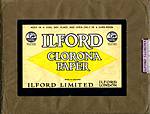 Ilford Clorona paper introduced in 1933
(?). Scan sent by "David". To see an enlarged version
of the illustration, click on the thumbnail or here. Ilford Clorona paper introduced in 1933
(?). Scan sent by "David". To see an enlarged version
of the illustration, click on the thumbnail or here.Michael Talbert reports that warm tones on Ilford “Clorona” paper were popular in the 1930s. The Ilford Manual for 1935 gives two print developers, ID-23 and ID-24, suitable for producing warm-black to sepia to red tones on Clorona paper. The Ilford Manual also states that Clorona paper required a negative of “Fair contrast” when brown-sepia to red tones were desired. As the tone of the print changed from brown-black to sepia and finally to red, the visual contrast decreased, so a negative of fairly high contrast usually gave the best results. This is exactly what Michael found in the 1960s using Kodak's equivalent, Royal Bromesko paper. |
|||
|
|
It describes the various plates, flat film and roll films available at that time, with useful information relating to their H&D speed rating, exposure and development (tank and dish). It concludes by considering negative defects and describes reduction and intensification techniques, plus how to avoid dichroic fog, 'frilling', halation and coloured patches. Selo panchromatic (see entry above) is rated at H&D (Hurter & Driffield) 1,200; perhaps 100ASA, barely medium speed by modern standards. Possibly it was this film which was improved and became Hypersensitive Panchromatic (HP) - see below. |
||
|
The Courier was a 215mm by 135mm, 14 page, marketing booklet to convey Ilford company strategy to the trade. It was particularly concerned with encouraging good marketing by the trade in their direct contact with customers. This particular issue was wishing the trade to offer the new Selo Rayon printing paper, with 3½"x2½" prints costing 'only' ½d (old pence) more, at 2½d (1p) per print, instead of 2d for the long established glossy paper. Selo costumes, to imitate the Selo girl and the Selo soldier, were available on hire to the trade free of charge and carriage paid, "use them for your local hospital carniivals, fetes etc". (See 1939, below, for another issue of the Courier, celebrating 60years of Ilford). |
|||
|
The scan was sent to me by Marc Akemann, a US member of the APUG internet forum. Click here or on the thumbnail to see a larger image. |
|||
|
|
These HP and FP roll films were the fore-runners to the famous HP and FP roll and 35mm film series which culminated in HP5+ (1989) and FP4+ (1990). |
||
|
Ilford Ltd acquired an interest
in Dufay-Chromex Ltd. (14-16 Cockspur Street, London; later Dufay
Ltd.) for whom it started to manufacture a reversal colour film
of the additive type under the brand name Dufaycolor. Dufaycolor had previously
(from 1932) been available in England only as 16mm & 9.5mm
ciné film, but Ilford's expertise and finance enabled
it to be marketed for still photography in 35mm, roll, sheet
and film pack forms. Although processing was relatively simple
(and instructions were published), Ilford offered a service for
roll films. Ilford came under the control of the Ministry of Aircraft Production at the outbreak of war in 1939 and post-1945 it didn't resume an interest in additive colour (prior to WW2, Ilford had already started R&D into subtractive colour). However, Dufay Ltd survived into the 1950s and Dufaycolor film was still being disposed through Amateur Photographer 'small ads' in the early 1960s; viz. a 100ft 35mm bulk roll is priced at £1 and a 50ft roll at 12/6d (62.5p). Processing kits for four films are priced at 12/6d (62.5p) or processing vouchers (presumably for one film) at 6/- (30p). To watch a 9minute Dufaycolor film featuring the Selo Film Laboratory, at Brentwood, Essex, click here (catalogue No.6947 of the East Anglian Film Archive within the University of East Anglia ~ UEA) Other films relating to the Selo
Factory, viewable at the East Aglian Film Archive, are: |
|||
|
Recommended Ilford lantern plates are 'Special' for brilliant black tone, 'Warm Black' for warm image tone, 'Alpha' for slide making by contact and 'Gaslight', which can be handled in subdued artificial light and especially suitable for weak negatives. The rear page shows the booklet to be printed in England with a J35 footnote, indicating October 1935. Amateur films are listed as Selochrome, the extra fast roll film for fine grain, Selo Fine Grain Panchromatic roll film, fully colour corrected and of extreme speed and fine grain, and Selo Hypersensitive Panchromatic Roll Film, "the fastest panchromatic roll film made". |
|||
 A photograph of an attractive young lady
whose dress is bedecked with many Selochrome film boxes. A photograph of an attractive young lady
whose dress is bedecked with many Selochrome film boxes.Sent by Paul Knudsen of Phoenix, Arizona, USA but the picture was actually found by a lady named Angel Burke from Prescott Arizona who procured it in an estate sale. It had been pasted in a scrap book at one time. Paul writes that he is not sure whether its an Ilford advertisement or more likely it was a models print as it has a pebble surface not suitable for print reproduction. I have dated the picture by (possibly) identifying the camera the lady is holding - a Kodak Junior 620 of 1935 vintage. Click here, or on the thumbnail image, to see an enlarged version. |
|||
|
The instruction leaflet with this film pack was printed in April 1934 (D34) but is presumably an instruction leaflet appropriate to all contemporary Ilford Film Packs so may not have been printed for this specific film. 'Silver by the Ton' lists the Selochrome 'Super Speed' film pack's first appearance to 1935. |
|||
|
I believe their use was in high contrast copying. The recommended developer was ID13, which was Ilford's developer for 'photomechanical work' resulting in 'screen' or 'line' negatives or positives. After the plates were developed & fixed the resulting image could be cleared (using Farmer's reducer which increases contrast) or bleached and intensified. All the relevant formulae appear on the front of the box, beneath the title 'ILFORD PROCESS PLATES', and the box has the footnote D35, indicating its selling date was probably April 1935. |
|||
| An Ilford Limited souvenir book for the George V Silver Jubilee on 6th May 1935 is known to exist, presumably of similar format to that of the 12th May 1937 (see below) souvenir booklet produced by Ilford Ltd for the Coronation of George VI and Queen Elizabeth (Queen mother to Elizabeth II). One YouTube video of the Jubilee event is viewable here. | |||
| By 1935, Ilford
was marketing Selo 16mm 'safety' cine film (positive, negative
and reversal). Mat Simpson has sent me a link to a sequence of films shot by his grandfather, believed around the time 16mm cine film was first introduced by Ilford. Although Kodak introduced the monochrome 16mm format in 1923, it would have been expensive and so may not have been widely used in the UK. Mat's grandfather's film is a wonderful record of happy middle class family life in the mid to late 1930s and a credit to Mat's grandfather's skill with a cine camera. Confirmation of the use of Selo film can be found at the points 6m 58s into the film and again at 16m 41s. The 'End' title 'shot' shown at 6m 58s was probably a cardboard 'still' made available by Ilford for the convenience of their film users but also it made sure that films included an advert (that would be viewed by the audience) of their Selo product. Mat believes his grandfather was working in management for Ilford during the time the film sequences were shot. |
|||
|
|
An Ilford Selo print
envelope shows that developing a Selo film cost 6d (2.5p) and
each print cost 2½d (1p). Around this same time in the
UK a loaf of bread cost 1.4p, a pint of milk cost 1.3p and the
average cost of a house was £515. With Ilford size No.20 'Selo' b&w film costing 1/- (5p), taking 8 exposures and having the film developed and printed would have cost around 3/2d (16p), or the equivalent of over £11 in 2020. In 2009 a pint of milk cost around 45p and a loaf of bread 65p, all around a 40x increase over the mid-1930s. But house prices are up over 300x. |
||
|
A copy of "The Ilford Message" magazine [volume 1 number 3] was auctioned through ebay January 2006. I've no information on this publication, so anyone who recognises it, I'd be interested to learn more. The ebay vendor described it as being supplied FREE by Ilford to various photographic shops & distributors, to promote Ilford products. This particular edition contains a centre spread on the 'new' Dufaycolor film (probably an announcement relating to Ilford's involvement in this technology which began in 1935, see above). |
|||
|
An Ilford Graphic Arts materials catalogue dated September 1936. Its rather nice cover shows sheet films and plate boxes from 1936. To view it in more detail and also three of its pages, click the image or here. The fastest material in those days was Ilford Hypersensitive plates, rated at 2500 H and D, or about 100 ISO. The sheet film version was rated at 2000 H and D, or about 80 ISO. Information and images courtesy of Michael Talbert. |
|||
|
|
Ilford FP1, FP2 (125ASA) and HP2 Plates introduced. | ||
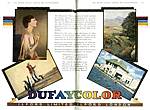 In July 1937 Ilford stopped marketing Dufaycolor (announcement in Miniature Camera Magazine) and the responsibility reverted to Dufay-Chromex Ltd of Elstree, Hertfordshire (could this be the previous Wellington & Ward premises ?). At that time, Mr George H Sewell, ARPS (a well known amateur cinephotographer and author) was Sales Manager at Dufay. This change possibly coincided with the start of Ilford's R&D into its own subtractive colour film process. Despite this, there is an Ilford 4-page colour advertisement promoting Dufaycolor in the British Journal Photographic Almanac (BJPA) for 1937. |
|||
 Ilford Selochrome Plates, speed rating
Ilford E = 64ASA pre-1960 speed revision. Afterwards 125ASA. Ilford Selochrome Plates, speed rating
Ilford E = 64ASA pre-1960 speed revision. Afterwards 125ASA. |
|||
|
It lists formulae for Ilford Developer (ID) 1, 2, 3, 4, 6, 9, 11 (i.e. the famous ID-11, same as Kodak's D-76), 13, 14, 15, 16, 17, 18, 19, 20, 21, 22, 23, 24, 25, 29, 30, 33, 34, 35, and 36, and advises on their specific uses. There is also much other chemical information on toning prints, hypo eliminator, emulsion hardening, rapid drying, desensitization, intensifiers and reducers, fixing baths, developer stain removing etc etc. Cezar Popescu has kindly provided me with a scanned version of this booklet, which he has made word searchable by using OCR software. Click the image to download it as a 5MB pdf file. |
|||
|
But it was a precision instrument and, post-WW2, the many that survived, probably having had relatively little use since new, were given a new lease of life by the introduction of a roll film back taking the 828 "Bantam" film size, giving 8 exposures 24mmx36mm. To read a 1958 article from Modern camera Magazine (MCM) describing this new (in 1958) roll film back, click here. |
|||
 In
celebration of the 12th May 1937 Coronation of George VI and
Queen Elizabeth, Ilford Limited produced a souvenir book of photographs
taken by photographers working for Newspapers and Press Agencies.
All original negatives were on Ilford Hypersensitive Panchromatic
Plates and Ilford Double-X-Press Plates. In
celebration of the 12th May 1937 Coronation of George VI and
Queen Elizabeth, Ilford Limited produced a souvenir book of photographs
taken by photographers working for Newspapers and Press Agencies.
All original negatives were on Ilford Hypersensitive Panchromatic
Plates and Ilford Double-X-Press Plates.Click here or on the image to download a pdf of the book. Be patient as it is a 10MB file. Book made available by courtesy of David Muggleton. |
|||
|
The book contains the separate
Ilford 'colour' test chart, illustrated alongside. |
|||
|
Paul Godfrey, who was a member of the GYDPS in his youth (he left in 1968) keeps in touch with friends who are still members. It was through that connection that Paul was able to send me the scan of the cover of the booklet and also a pdf file of the book's contents. Click here or on the thumbnail of the cover (left) to download the pdf. It extols the virtues of Selo Hypersensitive Panchromatic roll film and plates (35mm users had to wait until 1938 for the release of HP2). Paul points out the similarity between this booklet (dated November 1937; K37) with the booklet 'Winter and Night Photography ~ Indoors and Out' which is shown below in the (August) 1938 'slot'. The difference seems to be that the 1938 booklet includes mention of HP2 film for the 35mm user. |
|||
| My thanks to Murray-Rust for sending me the following link, http://www.geograph.org.uk/photo/3071805, which shows a wall painted advertisement for Selo and Selochrome films. Presumably the wall was once part of a chemist's shop, when chemists were the normal source of photographic films, equipment, chemicals and developing&printing. Its exact date is unknown, but is believed to date before WW2. Although defaced by time and building modifications, it can be clearly seen to say "SELO FILMS. GET YOUR SELO AND SELOCHROME FILMS HERE. THE FILMS FOR BEST RESULTS." Then underneath it advertises "DEVELOPING & PRINTING". Notice that the background colour appears to be the usual Ilford yellow (ochre), used on their film packaging until the mid-1960s. For an example of this yellow, see the Selo film packaging in my 1930 'slot', above. | |||
|
|
Issue (Series 1 No 2) alongside
carries the information: Issue 2 must have been published in December 1938 as it carries the holly framed message "A Happy Christmas to all Photographers; Ilford Limited". Click the links to download and
read issues No.1 and No.2, believed to date to November
1938 and December
1938. |
||
 Ilford Anti-Halo
Fine Grain Ordinary Flat Film. Speed rating unknown. Ilford Anti-Halo
Fine Grain Ordinary Flat Film. Speed rating unknown. |
|||
 Ilford
Ordinary Plates introduced. Very slow speed, Ilford Group A,
Weston 3; equivalent to maybe 8ASA / ISO in the modern speed
rating system. Ilford
Ordinary Plates introduced. Very slow speed, Ilford Group A,
Weston 3; equivalent to maybe 8ASA / ISO in the modern speed
rating system.The film pack image shown here courtesy of Bernard Rose. Although plates bearing the name 'Ordinary' were first marketed in 1885, the name was revived for use in 1938. But this package must date from much later again - compare it with the earlier packaging of Fine Grain Flat Plates, shown above. Since it does not bear the paddle steamer trade mark, it likely dates from post-WW2. Ordinary Plates were still being sold in 1950. |
|||
 A leaflet scanned by Paul
Godfrey describing the use of Selo
'GasLight' paper, though ILFORD write in the leaflet "we
prefer to call it the paper for perfect print-making by artificial
Iight, since any form of artificial light may be used although
electric light, gaslight, or the light of oil and pressure spirit
lamps are preferable. This independence of daylight and the comfort
of printing in normal surroundings renders printing on Selo Paper
a very pleasant, and companionable evening occupation for the
winter". A leaflet scanned by Paul
Godfrey describing the use of Selo
'GasLight' paper, though ILFORD write in the leaflet "we
prefer to call it the paper for perfect print-making by artificial
Iight, since any form of artificial light may be used although
electric light, gaslight, or the light of oil and pressure spirit
lamps are preferable. This independence of daylight and the comfort
of printing in normal surroundings renders printing on Selo Paper
a very pleasant, and companionable evening occupation for the
winter".Click here on on the cover image alongside, to view the complete leaflet as a PDF file. Further images of Selo 'GasLight' paper packaging are courtesy of Simon Spaans and Bob Hindley. |
|||
|
As with the 22nd edition (see 1937 above) it deals with the needs of getting a truly correct rendering of all colours in terms of their grey scale brightness, set against a colour scale (see 1937 for a picture of that scale). Apart from any pictorial or scientific requirement, an accurate 'colour' bce of subjects recorded on black and white film was necessary for the production of colour 'separation' negatives as a step towards producing additive colour slides or subtractive process prints e.g. by the trichrome carbro process. |
|||
|
The Selo films 'family' at the time consisted of Selo Ortho (26°), Selo Chrome (29°), Selo F.P (27°) and Selo H.P. (31°), all being roll films, and Selo Chrome (27°), Selo F.P (24°) and Selo H.P.2 (31°) for 35mm cameras. Roll film H.P.2 and F.P.2 were introduced in 1939, see entry below. |
|||
 A cassette of 35mm 36 exposure Selo H.P.2
fim for "Leica etc". Speed rating = Ilford Group F
= 32 DIN. Thus, the film was rated at 125ASA, equivalent to a
250ASA emulsion after the 1960 'universal' speed rating revision,
(see notes at the end of my Chronology
Introduction web page). A cassette of 35mm 36 exposure Selo H.P.2
fim for "Leica etc". Speed rating = Ilford Group F
= 32 DIN. Thus, the film was rated at 125ASA, equivalent to a
250ASA emulsion after the 1960 'universal' speed rating revision,
(see notes at the end of my Chronology
Introduction web page). |
|||
|
|
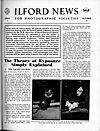  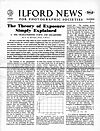 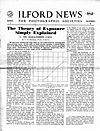 Ilford News issue No.3
for January, No.4
for February, No.5
for March and No.6
for April 1939 can be downloaded by clicking the links or
the thumbnails alongside. Issues No.1 and No.2 can be downloaded
from the 1938 chronology section (above). Issues Nos 1, 3 and
4 are available courtesy of Keith Walker. Ilford News issue No.3
for January, No.4
for February, No.5
for March and No.6
for April 1939 can be downloaded by clicking the links or
the thumbnails alongside. Issues No.1 and No.2 can be downloaded
from the 1938 chronology section (above). Issues Nos 1, 3 and
4 are available courtesy of Keith Walker. |
||
|
Apart from the Chairman (see
left) Major-General Sir Ivor Philipps, K.C.B; D.S.O, others named
are Mr F.F.Renwick (research dept); Dr.Olaf Bloch (photographic
emulsions); Dr.Kendall (sensitizing dyes in the Rodenside laboratory
- see the 1940 entry for his contribution to replacing the developing
agent Metol with Phenidone); Dr.G.B.Harrison & Dr.S.O.Rawling
(Selo Laboratories). |
|||
|
As in Ilford News (above) the Chairman Major-General Sir Ivor Philipps authored a 3 page account of the company's technology progress since it started 60 years previously. An interesting article on the exposure latitude of Selo film, where the film was subjected to exposures of the same sunny outdoors subject over an exposure range of 3,000:1, and claiming all negatives gave acceptable prints. From ten times under-exposed to 300 times over-exposed. Such latuitude was claimed to be good for film sales as snapshot success was virtually guaranteed. |
|||
| Ilford launched it's 'PLASTIKA' photographic paper (warm black image colour and wide exposure latitude - 9 paper surfaces) and a range of films. | |||
| H.P.2 (100ASA, equivalent to 200ASA post-1960)
replaced the original Hypersensitive Panchromatic rollfilm (see
1935, above) F.P.2 (40ASA, equivalent to 80ASA post-1960), Selo brand roll film launched. |
|||
|
For similar, see 1935. Thanks to David Muggleton for the loan of this booklet. |
|||
|
Dated H39, so August 1939, this booklet encourages the taking of pictures by artifical light, Photofloods and flash powder, so that photography can continue throughout the winter months. To view the complete booklet as a pdf, click the image or here. |
|||
|
It is owned by Christine Ellis and interestingly is of the less common 9.5mm format. Christine says "...taken in Warwickshire...The Selo reel is about 1939 (maybe 1940) as it contains film of my husband and his older brother ......." Also embossed onto the film spool are the words "FOR PROJECTOR USE ONLY". |
|||
|
To view some Wellington & Ward packaging, click here. The picture alongside, from this website, is believed to have been taken in the early 1900s. |
|||
|
|
Ilford launched
the world's first true 'MULTIGRADE' photographic paper, but it wasn't an immediate success.
The time was not yet right. Users were not equipped with filter-drawer
enlargers and the print quality was insufficiently consistent.
It was withdrawn by the end of the war. An entry in the British
Journal Photographic Almanac (BJPA) for 1941 reads "The
revolutionary new Ilford Development Paper 'Multigrade' is, as
is now fairly generally known, a material on which the contrast
of the print can be varied at will by altering the colour of
the printing light." For further Multigrade history, click here. 'Phenidone', Ilford's trademark for l-Phenyl-3-Pyrazolidone, was first prepared in 1890, however it was not until 1940 that Dr.J.D.Kendall, in the laboratories of Ilford Limited, discovered the photographic reducing properties of this chemical as an alternative to 'Metol'. |
||
|
Michael believes the packet dates to about 1940. He says: It’s got a code on the back “S31P” meaning Selo, (grade) 3, 1 (glossy), P (single weight). |
|||
|
|
Ilford Micro Neg Microfilm. | ||
|
For early HP3 packaging, view here. |
|||
.jpg) Orion Bromide paper, sold in a hermetically
sealed metal tube, possibly for war-time use in tropical countries. Orion Bromide paper, sold in a hermetically
sealed metal tube, possibly for war-time use in tropical countries.This example was an e-bay purchase by Leon Bren, in Australia. He found the tin still had its original seal intact. When opened (in his darkroom) he found the paper was still able to produce very acceptable images after 71 years of uncertain 'storage'. Click the image to see more pictures and to read comment by Leon. |
|||
|
|
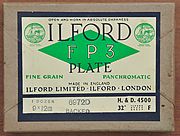  Ilford
launched FP3 and HP3 plates. FP3 is rated at 125ASA and HP3 at
200ASA, the latter higher than the 125ASA rating of HP3 film
released in 1941. Ilford
launched FP3 and HP3 plates. FP3 is rated at 125ASA and HP3 at
200ASA, the latter higher than the 125ASA rating of HP3 film
released in 1941.The picture of the box of FP3 plates by courtesy of Michael Talbert who says "...box of Ilford FP3 plates dating from 1942 to about 1946. They have an H & D speed of 4500, approximately 32 Scheiner or 125 ISO; quite a fast plate for those days. HP3 plates were only two thirds of a stop faster! FP3 became available as FP3 film about 1946; 35 mm at first but with a drastic speed reduction to 40 ISO. All above speeds refer to values prior to the re-rating which occurred in 1960. To see a larger version of this and other FP3 (and the later FP4) packaging, view here. To see a larger version of this and other HP3 (and later HPS) packaging, view here. |
||
 Selochrome roll film with a 1942 expiry
date. Selochrome roll film with a 1942 expiry
date. |
|||
|
Lancelot Vining, FRPS (Fellow
of the Royal Photographic Society and Member of the Council),
FIBP (Fellow of the Institute of British Photographers), was
one of the Ilford Team of Lecturers. Mr Vining was still providing
this Ilford service to photographic clubs in 1952/53, together
with Donald Allen, Karl Pollak and D S Moran. |
|||
|
Henry Russell wrote a feature called "Between Ourselves" under the pseudonym "Minicam" in Miniature Camera Magazine (MCM) from (almost) its inception until the mid-1950s. MCM first appeared around December 1936 and Henry's first contribution (6 pages) appeared in the October 1937 edition (Vol.1 No.11). The photograph is from the 'banner' at the top of the early editions. He ran his own company, handling advertising for Ilford, Photax and Johnsons. From 1938, until he died in 1960, Henry was responsible for 80% of Ilford's advertising copy. He also authored a considerable number of books on "miniature" photography. He was a respected Exhibition Judge and wrote articles under his own name for the monthly magazine 'Camera World' during the mid-1950s. |
|||
|
|
Alongside is shown an early box of HP3 Matt Sheet Film that was manufactured pre-1955, as the speed is shown as 125 Weston (=ASA=ISO). Ilford increased the speed of all HP3 film emulsions to 200 Weston (=ASA=ISO) around 1955 to bring the speed in line with HP3 plates. Experienced photographers could expose HP3 at 400 ASA (ISO) when developing in most of the Ilford film developers, with ID-48 being the exception but Microphen giving a slightly higher speed increase to 650 ASA (ISO). This box contained HP3 Matt Film,
which had a matt finish on the non-emulsion side, giving the
processed negatives a soft, flat appearance, although the contrast
was not altered by the matt finish. The purpose of the matt finish
was to give a surface for re-touching of the negative in pencil
or dye, as might be required for portrait negatives. It was much
easier to re-touch in pencil onto a matt surface than onto a
surface that would have otherwise been glossy. HP3 Cine and Aerial Film also first released. |
||
|
Images supplied by Michael Talbert |
|||
|
|
The image alongside, sent by
Mike Ratcliff, is believed to illustrate the type of box used
to supply this product. Click here,
or on the image, for an enlarged view. |
||
|
The 'Paddle Steamer' trademark
is on the LHS and the SELO trademark is on the RHS. |
|||
| John Alexander has emailed with recollections of working
in the original Ilford factory site at Roden Street, Ilford,
Essex, when he was a teenager. Click here to read his account of those times. |
|||
| Stan Scholes has e-mailed to say "My first job after leaving school in 1944 was at Dufay Chromex, Borehamwood, near Elstree, Hertfordshire., as a lab assistant earning £1 17s 6d. (£1.88p). .........of the 2 or 3 years I was at Borehamwood, I can only remember the name of my boss, Dr Walters. As laboratory assistant I was mainly involved in trying various dyes to find their stability to light and their colour spectrum for better cut off, ie blue that would not transmit any red etc. They had some of the processing tanks etc in some of the buildings but these were standing empty. The site at Borehamwood is now the Boulevard Shopping Centre." (Theobald Street, Borehamwood, Hertfordshire, WD6 4PR). | |||
|
|
The paddle-steamer trademark, used since 1886, was dropped and the new advertising slogan "Ilford films, for Faces and Places" was coined. Ilford's Lecture Service, which operated throughout the War (see 1942 above) announced "Today, with calm restored, we are more eager then ever to provide the services of our qualified team of lecturers, so if you have a vacant date, drop a line to the Ilford Lecture Service, Ilford Ltd, London." In AP for 5th September 1945, John Milner, the Hon. Sec. Petersfield Photographic Society writes "I feel the time has come to thank Messrs. Ilford, Ltd, publicly and wholeheartedly for the wonderful way in which they have helped photographic societies to carry on during the last five or six war years, by sending their lecturers and demonstrators all over the country, and at no cost whatever to the societies concerned. The Petersfield Photographic Society acknowledges that it owes this fine firm a great debt, and it is to be hoped that clubs and their members will bear in mind that the products of this company are second to none, when the market becomes flooded with foreign merchandise." |
||
|
A V-2 rocket landed on Ilford's original Roden
Street factory one day (this site, suggests 20th February 1945).
The emulsion laboratories were in an old building with the windows
permanently blocked out. The explosion blew the windows in so
that light could enter, and this interrupted manufacturing. See
the end of this web
page for more details. Thanks to David Mittelstadt for
pointing the following out to me, and to Martin Reed of Darkside
for its source. |
|||
|
|
Before the war Ilford imported
all its requirements of film base, first from the Celluloid
Corporation (USA) and later from Gevaert (Belgium). Imports
continued during the war, mainly from Du Pont (USA). In 1946,
at the suggestion of the Government, Ilford and B.X. Plastics
Ltd. set up a jointly owned company, Bexford Ltd., at Lawford,
near Manningtree, Essex, to manufacture cellulose acetate film
base. Christopher Webbe, in an e-mail July 2017, tells me "E.G. Couzens, my grandfather, was managing director of BX Plastics at the time that Bexford was established and who I understand had a hands-on role in solving the not insignificant problems of setting up a film casting operation. As an aside, Gordon Couzens was Research Manager at BX Plastics when Maggie Thatcher was engaged as a research chemist in the 1940s. Gordon Couzens wrote a number of books about plastics together with V E Yarsley. He also wrote a book called “A Short History of the Film Casting Process” in which Bexford has a somewhat prominent position and there are, of course, a number of mentions of Ilford". The company was acquired by Xylonite in the 1980s. Paul Godfrey reports that the BX factory complex is/was right beside the Norwich–London Liverpool Street railway and viewing from the train its possible to see that demolition contractors have nearly flattened the factory (Aug 2009). The site is now up for re-development. |
||
|
To view a larger image and other FP3 packaging, click on the image or here. |
|||
 This image was sent to me by Jim Fisk
of the Great Yarmouth Photographic Society (see the bottom of this web page) and a friend
of Paul
Godfrey. He says "It came from the Charlie Read collection". This image was sent to me by Jim Fisk
of the Great Yarmouth Photographic Society (see the bottom of this web page) and a friend
of Paul
Godfrey. He says "It came from the Charlie Read collection".It shows a box of six Selo H.P.3 35mm refills. "Ilford Speed Group F: Specially cut and numbered for use in Leica Cameras". Click on the image, or here, to see an enlarged view. The expiry date of these films was July 1948. The packaging lacks the Paddle Steamer trademark, which (as stated in the 1945 'slot' above) was 'dropped' in 1945, so it seems this pack was made around 1946, meaning it was one of the last packs of film refills made with the 'Selo H.P.3' name. Shortly after 1946 the name 'Selo' seems to have been dropped by Ilford and the film became just H.P.3. In another couple of years it was named simply HP3, i.e. no stops between the letters. The original instruction booklet for the Ilford Exposure Meter Model B (on its page 8) shows that, even at the time the booklet was produced (March 1938), the Ilford Speed Group range had already increased to include the letter 'F', necessitated by "the recent increase in speeds of Ilford Hypersensitive Panchromatic Plates and Films". This presumably refers to H.P.2 becoming available in the 35mm format in 1938. |
|||
|
Ilford speed rating 'E', B.S.I. Scheiner 29°. Equivalent to ASA 64 (same speed as the FP3 film above). |
|||
|
Tony quotes the Ilford advertising slogan "Focus right then gently press: Ilford Selo spells success". It was widely used in newspaper and magazine adverts of the time and certainly during the latter years of the war. He recalls it was often associated with an attractive girl posing provocatively, a camera to her eye, taking a ‘snap’ of her boy friend or scenic view. |
|||
|
|
 Ilford announce
a sophisticated 35mm interchangeable lens rangefinder camera
called the "Witness",
but it was slow to reach the market for various reasons, including
a shortage of high quality lenses (see 1950 & 1953). The
Witness was conceived by Werner Rothschild, who had worked in
the German camera industry during the 1930s and, after the war,
started the UK photographic company Daroth (an abbreviation in
part derived from the surname Rothschild) and similarly used
Daron as a lens name. Robert Sternberg was a working colleague
of Rothschild who played the major role in designing the Witness
(see 1991). Ilford announce
a sophisticated 35mm interchangeable lens rangefinder camera
called the "Witness",
but it was slow to reach the market for various reasons, including
a shortage of high quality lenses (see 1950 & 1953). The
Witness was conceived by Werner Rothschild, who had worked in
the German camera industry during the 1930s and, after the war,
started the UK photographic company Daroth (an abbreviation in
part derived from the surname Rothschild) and similarly used
Daron as a lens name. Robert Sternberg was a working colleague
of Rothschild who played the major role in designing the Witness
(see 1991).Manufacture of the Witness was later taken over by Peto Scott Electrical Instruments. |
||
|
A small pocket in the rear cover of the booklet contains "Specimen Surfaces of Ilford Bromide, Plastika and Contact papers". Some images of Ilford Bromide printing paper from around this time can be seen here, courtesy of Simon Spaans. |
|||
|
1947 British Industries Fair Advert as Manufacturers of the Copycat Non-optical Facsimile Copying Machines, complete developing process and print driers. No dark room. "Copylith" Reflex copying dyeline prints and preparation of Lithographic Plates . In November 1947, Miles Aircraft ceased trading. There were many reasons for their financial problems, not all of the company's making and questions remain about the behaviour of the Ministry of Aircraft Production, the company's bank and certain of its financial advisors. In fact, when the company was restructured, many non-aircraft activities prospered in other hands, notably the Biro pen, the Copycat photocopier and its range of electric actuators. 1947 Listed Exhibitor - British Industries Fair. Manufacturers of Photographic Plates, Papers, Films, Accessories, Apparatus, Chemicals, X-Ray Films, Paper, Intensifying Screens, X-Ray Accessories, Apparatus, Materials and Apparatus for document Copying, Materials for Cathode Ray Recording, Glazing and Drying Machines (Olympia, Ground Floor, Stand No. E.1783). Ilford made an Ilford Reflex
Document Paper No.50 for use with the Miles Copycat and apparently
put their name to the Reflex Printer itself, though the printer
was manufactured by Miles Aircraft Ltd of Reading, England. |
|||
|
|
 ILFORD
launched its first Colour
Film "D" 10 ASA. (and in 1956 Type "F"
for clear flashbulbs) This was (unusually) a non-substantive
reversal film, as was Kodachrome. ILFORD
launched its first Colour
Film "D" 10 ASA. (and in 1956 Type "F"
for clear flashbulbs) This was (unusually) a non-substantive
reversal film, as was Kodachrome.To read a full account of Ilford's attempts over the following 20 years to move into the field of colour film photography, click here. |
||
|
Work started on a silver dye-bleach process for making prints directly from colour transparancies, pioneered by Dr Bela Gaspar in the 1930s but mainly used for motion pictures (Gaspar based his work on that started by Austrian, Karl Schnitzel, in 1905). The process, which eventually became Cibachrome (see 1963), produced the first successful prints around 1949. This work lead to the launch, in 1953, of a service to provide colour prints from transparencies Take a look at THE PHOTOGRAPHIC HISTORICAL SOCIETY OF CANADA site where there is a page devoted to Alf Pyner, who joined Ilford after his time in the RAF during WW2 and had a long association with Ilford’s experiments to develop colour materials. |
|||
| Pan
F b&w film first appeared,
initially as 35mm and a short time later as 16mm cine film stock.
At that time it was rated at the lower (than later Pan F)
film speed of 23° Scheiner (Ilford Exposure Meter C; ASA
16). In November 1956 (ref: Camera World magazine) Pan F speed was increased to Scheiner 25°, ASA 25 (ASA 16 in tungsten light). Post-1960 Pan F became 50ASA in daylight, when the same emulsion was re-rated in speed (as were all b&w films at that time). |
|||
| The Borough of Ilford
presented Princess Elizabeth with a specially commissioned ILFORD
Advocate Camera, costing £340. The camera was stolen, but later recovered, when it was sent to be repaired. |
|||
|
The 70th year Anniversary was
held on 12th November 1948 at the Cafe Royal, Regent Street,
London, W.1. The 75th anniversary celebration was held in May 1954. |
|||
|
|
Ilford Colour Film Type "A" introduced. Amateur Photographer magazine for 30th November has a Wallace Heaton advert which prices 35mm Ilford daylight Type 'D' colour film in 18 (half length) exposure cassettes at 16s/4d (82p) and 20 exposure Type 'A' cassettes at 18s/6d (92.5p), including processing. Postage extra 4d (1.5p). By 1955 both films were sold in 20 exposure cassettes for 21s/6d (£1.8p), inclusive of processing. The 1949 BJPA (p239) carries
an announcement of 'Ilford Sellotape'. "Sellotape is
a self-adhesive, clear cellulose tape which adheres firmly to
almost any surface. It is strong and pliable, and thus suitable
for many sealing purposes, and other darkroom and studio uses.
Sellotape is supplied in rolls, 8½yds in length by 5/8inch
wide, in a metal dispenser which can be carried in the pocket
and into which refill rolls can easily be loaded. The top of
this container allows the required length of Sellotape to be
torn off with either a straight or a saw toothed edge. The price
of the dispenser, complete with a roll of Sellotape, is 2s.(10p),
plus purchase tax; refill rolls cost 1s.(5p) each, plus purchase
tax." |
||
|
The Craftsman was assembled in the same factory, Northern Scientific Equipment Ltd; Bark Street, Bolton, as the Witness. |
|||
Calibrated in both the Ilford Speed Group lettering system (A - G) and Scheiner degrees. Ilford's speed group lettering was later extended to cover a range A -H in order to include newer, higher speed, emulsions e.g HPS in 1952. "One operation determines camera exposure". To view a large colour image of an Ilford Meter Model C and read the 1950 BJPA report, click here or the image. Colour picture Courtesy of David Muggleton. |
|||
| Click here for some Selo Factory football team memories. | |||
|
|
There is some uncertainty, but it is possible that a prototype of the Ilford 'Witness' (see 1947) was first exhibited in late 1949 or 1950. | ||
| Dowload copies
of 'Between Ourselves', an Ilford magazine for all its workers,
wherever and however they were employed. Full of social commentary
of the time. Provide by Martin Reed of Darkside Photography, importer of Foma b&w materials. Between Ourselves, Nov1949. Between Ourselves, August 1951. Between Ourselves, December 1955. Between Ourselves, September 1959. |
|||
|
|
14th March, the company formally changed its name from Ilford, Limited to Ilford Limited (omitting the comma) although in practice the comma had been omitted frequently over many years (my thanks to Gavin Ritchie for this item). | ||
|
The Prentice cost £3.13s.6d
plus £1.11s.1d purchase tax (£5.23p). |
|||
|
"This year, when more people
than ever will be taking photographs of places visited and of
the friends with whom they will share the enjoyment of the Festival
celebration, increasing numbers of discriminating amateur photographers
will be putting their trust in Ilford films." |
|||
| In 1951, Ilford
Australia Pty Ltd, was set up in West Melbourne, Australia, originally with
a staff of about 10. By 1955 (see below) the company had expanded and was relocated to a site 3 or 4 miles from Mount Waverley called Notting Hill. The Notting Hill factory was occupied until 2003. |
|||
|
|
In 1952 Ilford and Geigy set up Gyl Chemicals Ltd to manufacture Hydroquinone. |
||
|
Michael Talbert comments "In
1973, when I was working for as an assistant to a photographer
in Canterbury as his B/W printer, he happened to mention that
he used HPS plates from the time of their 1952 introduction.
At that time, he told me, the first boxes of plates came with
a label advising, because of their very high speed, that the
plates had to be used within a certain time, ( I forget how long,
maybe it was around 3 months), or the speed of the plates would
gradually diminish. . Later on Ilford managed to “hold the
speed” at 800 ASA for the “normal keeping time",
as with their HPS film emulsions. The same Canterbury photographer thought that HPS plates were HP3 plates which had been hypersensitized, a technique dating back to the 1930s for increasing the speed of any emulsion. About a year later Kodak introduced “Kodak Press Special, P 2000” plates, rated at 500 ASA incl. a speed safety factor, with 1000 ASA a workable speed. I am sure they had the same trouble as Ilford in maintaining the speed of these plates as D76 wasn't the recommended developer. Kodak Press Contrast or D 61A gave the full 1000 ASA. By the early 1960s P 2000 had quietly disappeared; Kodak's Royal X Pan film took it’s place from autumn 1958 with an official daylight speed of 650ASA, but Kodak encouraged its use at 1600ASA and even higher with extended development. The box of 12 off 4" x 5"
HPS plates illustrated probably dates from after 1956 because
the three speed ratings are: |
|||
| Jack H.Coote, Hon.FRPS, FIIP, joined Ilford Limited. Mr Coote was involved in photography from 1937. He started by working in commercial and industrial fields and then spent some time in the motion-picture and photofinishing industries before joining Ilford Limited to establish a colour processing laboratory. Subsequently he became Head of Technical Services for the Ilford Group and then Technical Advisor to the Head of Marketing. He authored 'The Focal Guide to Colour Printing from Negatives & Slides', 'Colour Prints', 'Focal Guide to Cibachrome' and 'Monochrome Darkroom Practice', as well as being an occasional contributor to Amateur Photographer magazine. Paul Godfrey tells me Jack also authored 'The Illustrated History of Colour Photography' in 1994, a good read which describes various processes including Autochrome and Dufay and continuing through Agfa, Kodak and Ilford. | |||
|
Apparently produced regularly during the 1950s and into the 1960s for trade distribution (e.g see 1955). Thanks to David Muggleton for the loan of this copy. |
|||
|
|
The Ilford 'Witness' camera finally reaches the mass market, but only some 350 are ever produced. It failed against competition from the newly released Leica M3 and problems with its mass production. In April 1953 the Witness was priced at £121.16s.8d (£121.83p) with a f1.9 lens. | ||
|
Ilford PIM (Photographic Instrument Manufacturers) Monorail professional plate camera with a triangular-section rail marketed by Ilford Ltd (see picture). |
|||
|
Coming from the work started in 1948, the year of 1953 saw the launch of a service to provide colour prints from transparencies, both from Ilford's Colour "D" transparency film (launched in 1948) and also from Kodachrome. This was the operation that Jack Coote had been hired to manage (see 1952 'slot', above) and was based in Richmond (Surrey, UK). Ciba independently chose to use the same process to formulate the eventual industry leading Cibachrome process. Cibachrome enabled professionals and home workers to make excellent colour prints directly from colour transparencies. Based upon a reversal process yielding a positive print direct from a positive transparency, print production quickly rose to more than a million prints per annum. The service was only available to 35mm slide film users. Prints 5½"x3¾" with a white border. Price per print was 2/6d (12.5p) with a minimum order of four prints from one or more transparencies. |
|||
| Release of Envoy Box, Series 1 (?not sure of this year date?) | |||
| Release of Ilford 'Advocate' camera Series 2, with 35mm f3.5 Dallmeyer bloomed lens and flash synchronised, priced at £26.17s.6d (£26.88p). In this Coronation Year of Princess Elizabeth as Queen Elizabeth II, Mount Everest was finally conquered. The exploration team used Advocate cameras to record their climb, a ready made scoop for Ilford's advertising department. | |||
|
'Multigrade' variable contrast printing paper re-introduced May 1953. |
|||
|
Developers are now ID-1, 2, 3, 4, 6, 9, 11, 13, 19, 20 (Phenidone & Metol versions), 22, 33, 34, 36 (Phenidone and Metol versions), 42, 46, 47, 48, 55, 60, 61, 62 & 66. Pre-packaged developers include Contrast FF, Document paper (ID-55), Formalith, PFP (ID-62) and PQ Universal. Book also describes various fixers, hardeners, stop-baths, reducers, intensifiers, toners and packed chemicals. To view the first 25 pages, which cover the Ilford Developers, click here or on the image. Booklet owned by David Muggleton. |
|||
| To view an instruction sheet on the use and processing of FP3 and HP3 roll films, dated October 1953, click here. | |||
|
Intended for use by retailers to show the general public the range of Ilford items available. Each booklet would bear the name of the dealer and no doubt dealers would give copies away to regular customers for them to browse at home. Packed with information within its 74 illustrated pages. Note the cover has the Ilford text logo of the time "for faces and places". My thanks to David Muggleton for this copy. |
|||
|
To view an enlarged image, click here or on the image. Manufacture of HPS film in all formats ceased by 1971, but it was still possible to find out dated boxes of HPS sheet film offered for sale at surplus photographic material dealers, such as A.W. Young, Marston and Heard, plus others, in the late 1970s. It is believed the highest speed film on the market prior to HPS was Eastman Kodak's “Super Panchro Press – Sports Type”, a sheet film with an ASA (ISO) speed of 250. The 250 rating included the usual (for the time) “Safety Factor” of one stop, such that its true speed was 500ASA (ISO). "Super Panchro Press - Sports Type" was only made in sheet film format and was only available in the USA. |
|||
|
|
HPS was still available as conventional still camera
film stock (roll & 35mm) up to the late-1960s. Processing
details for roll and 35mm versions last appear in the Johnsons
Year Book for 1969. After 1969, HPS only appears in the Johnson
Year Book as 'narrow gauge cine film'. It continues to appear
as cine film up to 1971, when the Year Book was last sold. |
||
| Thanks to Roger
Gittins for directing me to a copy of the Ilford
House Magazine for May 1954. It was found on Martin Reed's previous Silverprint website. Martin now runs a website called Darkside. |
|||
|
The picture illustrates the type
of card slide mount used by Ilford for their Colour D transparency
film in 1954. Plain white on the reverse. |
|||
| BJPA publishing
arrangements: In Amateur
Photographer magazine for 24th March 1954 there is an announcement,
within the advertisement by R.G.Lewis Ltd. (125 Strand, London,
W.C.2.), saying: "Every year, the B.J.Almanac is published in a limited edition and it contains in its 600 pages interesting articles by renowned experts, descriptions of new methods, materials, processes, formulae etc. In both professional and amateur photographic circles it is regarded as the book of the year. Every page, even the coloured advertisements, is covered with useful information that sooner or later needs to be referred to. Publication is expected at the end of this month and in view of the usual heavy demand we shall be glad to reserve your copy now, upon receipt of remittance. Linson Board Covers, 5/- (25p); Cloth Bound, 7/6d (37.5p). Postage 8d. (3p) each." This indicates that (in 1954 at least) publication was in early spring, but it contained information relevant to the previous 12 months. Hence, the 1954 B.J.P.A held information relevant to 1953. |
|||
| Click here for some Selo Factory football team memories. | |||
|
|
Type 'A' & 'D' colour transparency films sold in 20 exposure cassettes for 21s/6d (£1.8p), inclusive of processing (see 1949 entry for earlier prices). A scan of a June 1955 Ilford leaflet describing their "colour prints from transparencies" service is available here (courtesy of Paul Godfrey). It predates the black and white negative service and duplicate slide service. Ilford Photographic Materials General Catalogue; a substantial 233mm x 157mm hard backed 328 page book, apparently produced regularly during the 1950s and into the 1960s for trade distribution. Doug McKee tells me that his 1956 copy has 336 pages. Around 1955 (see AP Jan 1956,
article by J.Rufus), HP3 film speed increased to 200ASA (post-1960
to 400ASA). This speed increase was fortunate because in 1955
the famous Kodak Tri-X roll film appeared - first on the Continent,
later in the UK. It subsequently also became available as 35mm. |
||
|
In 1955, Ilford Australia Pty
Ltd was relocated to a site called Notting Hill. This factory
was occupied until 2003. The site may have been purchased
around 1953 (see p81: Silver by the Ton). Mary Hildebrandt tells me: Click here to view some pictures of the Notting Hill site in Australia, sent to me by David J Arnold, who works for the Australia and New Zed Banking Group Ltd (ANZ), which is located on a site adjacent to where Ilford, Notting Hill, used to be situated. David's pictures date back to the time when Ilford first began to operate from there, through to the site's demolition in 2006. Marc Payet, who used to be National
Sales Manager of the Australian ILFORD subsidiary, has told me
it actually closed in 2005 and a distributor was appointed -
CR Kennedy & Company Pty Ltd. |
|||
|
As with the 1947 version, there is enclosed within the rear cover fold, a separate sample 'book' of paper surfaces from the Bromide, Plastika, Contact and Multigrade paper ranges. Interestingly, the price charged
for this 1955 booklet (now slightly larger at 52 pages) remained
at 2s/6d (13.5p). A similar set of Bromide, Plastika and Contact paper samples can be see here, courtesy of Michael Talbert. |
|||
|
It was perhaps aimed more at the amateur market than the hard back General Catalogue illustrated above. The back cover has a space for a retailer to stamp his shop's name & address (though the example shown bears no such stamp) and such a retailer might have given copies to regular customers to encourage them to browse at home and select further purchases from his shop. |
|||
|
The box alongside (date unknown) has a price of 14s.4d for 12 off 3½"x2½" (means 6p each). FP4 plates had a pre-1960 speed rating of 80ASA (at this time, FP3 film was 64ASA). To view a larger version of this plate box, clcick the image or here. |
|||
|
|
Ilford Advocate Series 1 (f4.5 lens) on sale secondhand for £11 at Theodore Pyke, Eden St; Kingston-on-Thames (AP Magazine, 26th Dec 1956). The Advocate Series 2 since 1953 offered flash synchronisation and a larger aperture lens, f3.5 instead of f4.5.
Introduction of a colour transparency duplication service, 4/- each (20p). Black & white negatives from colour transparencies, 2/6d each (12.5p). A spring 1956 Ilford leaflet
describing the use of Ilford transparency 35mm films Types A
& D, is available as a PDF file (courtesy of Paul Godfrey) by clicking
here. 20 exposure cassettes of either Type D or Type A cost
21s.6d (£1 & 7.5p) inclusive of processing. Another leaflet scan from Paul Godfrey is this one, from October 1956, extolling the low light virtues of HP3 and HPS films. Paul says "This has some very dated photographs in it but I do like the street scene with the Jowett Javelin complete with radiator muff. When I was a child I really liked these cars". Before the days of electric thermostatically controlled radiator fans, when fans were directly driven by the engine, it was usual to place some sort of insulating muff in front of a car's radiator in winter to try to prevent over-cooling of the engine and improve the interior heater's performance. Pan F film speed raised (autumn 1956) from its 1948 introduction speed of 16ASA (daylight) 10ASA (tungsten) to 25ASA & 16ASA respectively.The price of 36 exposure cassettes was 8s.3d (41p) and darkroom loading refills were 4s.8d (23p). Around April time, Ilford announced the availability of HPS in the additional roll film sizes of 127 and 620, at the same prices as their equivalent panchromatic roill films. Bookings for Ilford Lectures
for the 1956-57 (autumn 1956 - spring 1957) season started on
1st February 1956. The Lecture Team consisted of Lancelot Vining,
Donald Allen, D.S.Moran and Karl Pollak. |
||
|
|
Around the start of 1957, Ilford changed their advertisement address from Ilford Limited, Ilford, London to Ilford Limited, Ilford, Essex. | ||
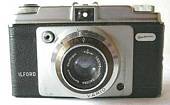 Ilford 'Sportsman' camera range introduced, see my index page for details of all the Sportsman camera 'family'. |
|||
|
In early 1957 Ilford announced an extension to their 1953 'prints from transparencies' service to include making duplicates and prints from any make of colour transparency from 35mm film and smaller. The full size 35mm transparencies were printed 5½"x3¾" with smaller transparencies printed in proportion. Monochrome negatives from 35mm transparencies could also be supplied at 2s/6d each (12.5p). The Basildon factory, which was built by the company, was completed in 1957. It became the factory for processing Ilford's colour films. Other activities eventually (by 1964) included the making of colour prints, colour printing from transparencies and the manufacture of chemicals and equipment. FP3 no longer available in roll film sizes 116 & 616 (only 120, 620,127 & 828). HP3 was still available in all sizes incl. 116 & 616. |
|||
|
Camera World for Feb 1958 carried
an article entitled "Ilford's new Ramsden Laboratory at
Brentwood, Essex (see left; named after Colonel Ramsden, a late
director of the company) is the latest and most impressive development
in the firm's expansion scheme. The building covers 30,000square
feet on two floors, and houses three sections devoted to physics,
chemistry and testing. Even distilled water is on tap !" |
|||
|
|
For a short period during the 1950's, ICI marketed a negative-positive colour film for use by professional photographers. At this time ICI took some preliminary steps towards entering the amateur market. However, in 1958 ICI acquired 32% of Ilford's shares and an agreement was concluded which gave Ilford access to ICI's colour film research in the negative-positive field and provided for further research on colour photographic products and processes to be undertaken by ICI on behalf of Ilford. | ||
| A large paper finishing and distribution department was built at Mobberley. The whole paper manufacturing process was now at Mobberley and there was a large increase in the workforce. | |||
|
New Ilford office block completed at Ilford, Essex (reported in 'Photography' magazine, March 1958). Click this link to read an article from Modern Camera Magazine, April 1958, describing a visit to this Office building. The location and expansion of the Ilford site in the town of Ilford from the earliest times up to the late 1950s has been impressively researched by Nicholas Middleton. I can't recommend highly enough that anyone interested in researching the actual location of the various Ilford Ltd premises in Ilford should start by reading Nicholas' website, with his findings supported by many references plus photographs taken himself using an Ilford Sportsman camera. Taken from Nicholas' website "Possibly the last expansion of the Ilford site was the Renwick Laboratory, built on the west side of Uphall/Riverdene Road, on land where some of the terraced houses built in 1907 had been destroyed by bombing in the Second World War. The laboratory, named after a former director of research, F. F. Renwick, opened in 1954. The site is now (2013) a relatively modern apartment block called Golding Court." |
|||
|
Ilford Ltd now employ about 4,000 people in England and over 500 abroad in subsidiary distributing companies including their new factory in Australia (for pictures see the 1955 chronology 'slot').. The company makes all its own film base, i.e. the non-inflammable plastic on which the emulsions are coated. Before the war this film base had to be imported, either from America or Belgium, and meant expenditure of foreign currencies. Now, in the £2 million factory built in association with BX Plastics (see the 1946 chronoloy 'slot'), all of llford's requirements are being met. |
|||
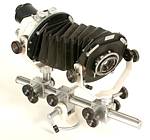 The
Kennedy Instruments
Ltd (KI) Monobar 35mm camera was produced, having a film
back with a resemblance to the Advocate camera. It was made during
the period 1958-65 and provided the range of lens panel movements
normally associated with a large plate 'field' camera. By 1967
the remaining KI Monobars were being sold solely by the goods
clearance company Marston & Heard for £60, against
a (claimed) list price of £180 (see AP magazine for 6_9_67). The
Kennedy Instruments
Ltd (KI) Monobar 35mm camera was produced, having a film
back with a resemblance to the Advocate camera. It was made during
the period 1958-65 and provided the range of lens panel movements
normally associated with a large plate 'field' camera. By 1967
the remaining KI Monobars were being sold solely by the goods
clearance company Marston & Heard for £60, against
a (claimed) list price of £180 (see AP magazine for 6_9_67).Kennedy Instruments Ltd were a wholly owned subsidiary of Ilford Ltd. (Ref: D.M, photo' courtesy of D.M) |
|||
| The 5th and final
edition of 'The
Ilford Manual of Photography' was published in May 1958 (see
1890 entry for first edition). This edition was subsequently reprinted a number of times; in 1959, 1960, 1962, twice in 1963, in 1966, in May 1967 and an 8th reprint (of the 5th edition final reprint) appeared in March 1968. Additional material in all reprints was included in appendices. In the 8th reprint, its appendices included information on split-image rangefinders, new types of film base, modern film speed systems, monobaths (one solution combined developer and fixer), high definition developers etc., as well as bringing up to date the inform,ation on Ilford products. The price of the 5th edition 7th reprint, in 1967, 'remained' at the 6th reprint price of £2.2s (£2.10p). Focal Press published a 6th edition in 1971 but without the name 'Ilford' in the title i.e. it was named simply 'The Manual of Photography'. Presumably the Rights to the book's content and its publication had been sold to Focal Press (possibly in 1969 when Ciba took over sole ownership of Ilford, Ltd ?). It reached its 9th edition in September 2000; ISBN: 0240515749 (Ref: D.M). A 10th edition appeared in 2011, published by Taylor & Francis ( my thanks to Ritchie Gavin). |
|||
| Ilford Colour Film D (Daylight balanced: Ilfordcolor is how Modern Camera Magazine referred to it) was first marketed in 1948 in 20 exposure packings. It became available in 36 exposure cassettes.in October 1958. The price of the new 36 exposure cassette was 30shillings (£1.50p), which compared favourably with the 20 exposure price of 20shillings (£1). The 36 exposure price meant that individual frames cost only 10d (old pence) each i.e. just over 4p. | |||
|
|
On August 4th 1959; Ilford introduced a modified cardboard transparency mount carrying the date of processing, the frame number and a black spot to aid correct orientation when being placed into a slide projector (as specified in British Standard No.1917:1952; the spot is seen at the lower left hand corner of the mount when the picture is viewed as it is to appear on the screen; hence to the top right hand corner when placed into a projector's slide carrier). The design was also claimed, in conjunction with the physical characetristics of the film itself, to reduce film 'buckle' through heat and also the tendency for images to 'pop' out of focus during projection. In October 1959, 35mm FP3
film became FP3 Series II. Ilford claimed "The new FP3
emulsion closely approaches ILFORD Pan F for fineness of grain
- yet its speed is maintained at 64 Weston!" A 20exp. cassette
cost 5s/1d (25.5p)and a 36exp. cassette cost 6s/10d (34p). Darkroom
loading refills, 36exp. cost 3s/11d (19.5p) and unspooled lengths
of 5m and 17m cost 10s/6d (52.5p) and 31s/11d (£1.60p)
respectively. Ilford have sites at (ref: PCCGB Tailboard magazine, Sept '06) Britannia Works - Essex, Basildon (filters), Bexford at Manningtree, Essex (filmbase), Brentwood (Selo) Works, Looe - Cornwall (processing), Margate (boxes), Mobberley - Cheshire (paper), Watford (gelatine). They are also supplying materials to Johnsons of Hendon. |
||
| Click here to download a PDF instruction sheet for the film developer ID-11 (= Kodak D76). It is dated July 1959, so predates the appearance of FP3 Series II. | |||
 Around April 1959 saw the introduction of the 4th generation of Multigrade, this time with 3 sets of 5 filters in each set. For conventional tunsten enlargers the first (softest grade) filters were magenta and the three normal to hard grades were yellow. Further sets were available for contact printing and cold-cathode enlarger lighting, that extended the density of yellow filtration. This version of Multigrade was removed from sale in April 1969. |
|||
|
Written by George Ashton, it
deals with Ilford colour transparency films Types D and F. The basic advised exposure for Type D on a sunny day was 1/50th sec at f 6.3, corresponding to the film speed of 10ASA. |
|||
|
Andrew Redding has sent me (Feb. 2021) the film box, instructions and return postal bag, plus the protective screw top container, that an 828 Bantam roll of Ilford Colour Film 'D' came in, probably in 1959. He hopes to use the film itself and develop it to black & white negatives. To see all these items in detail, click here or on the image. |
|||
|
Paul Rumbol, a Cliff Richard and Shadows specialist, has kindly sent me several radio adverts for the Sporti camera and Selochrome Film, dating from September 1960. Paul says "I've been transferring some of my old Radio Luxembourg audio recordings and came across this Ilford film ad from September 1960 which appeared weekly in the 'Me and My Shadows' Cliff Richard Show. Ilford sponsored the 13 week series (Thursday 7th July - 29th September at 9.45-10pm) and they also did the voiceover for the opening and closing themes. Cliff returned for more Luxembourg series in 1961 but Ever Ready sponsored the remainder of the shows, not Ilford". Click the links to hear the mp3 files: 1, 2 and 3. |
|||
|
|
Ilfachrome (10 ASA) daylight transparency film, cost 22/9d (£1.14p) for a 20exposure cassette and 34/1d (£1.70p) for a 36exposure cassette, including processing by Ilford. Transparencies returned in cardboard mounts. Ilford offered a service to provide duplicate transparencies or colour prints in two sizes, 3¾ x 5½ inches or 5½ x 8¼ inches with a 3/16 inch white border. Paul Godfrey has sent me a PDF file of an Ilfachrome leaflet that describes these services. Single duplicates are 3s.0d. (15p) each, 2 to 99 duplicates of a single transparency 2s.0d. (10p) each. The price of black-and-white negatives from 35mm transparencies is 2s.6d. (12.5p) each. The smaller colour prints cost 2s.6d (12.5p) each and the larger prints cost 7s.6d (38p) each. Paul adds "The Ilford Colour Film Duplicates and black and white negatives were produced on an Electronic Tone Masking Printer developed by Dennis M Neale that used a TV image to create the masking negative to control the contrast. This machine was described in a paper presented to the RPS in 1959. The Ilfachrome prints were made on a High Speed Printer that was developed by Walter Kennedy. This used a rotating filter system patented by Jack Coote and Philip Jenkins and was also described in a paper presented to the RPS on the same occasion in 1959". | ||
|
Ilfacolor was tested in Amateur
Photographer magazine, 16th November 1960; "Greys are reasonably
neutral with only a slight tendency to blueishness. The purple
end of the spectrum is quite faithfully reproduced, so are the
yellows, but the reds and oranges blur together. There is no
really bright 'pillar box' red (but nevertheless the reds are
better than some other unmasked processes). Some people found
the results acceptable, calling the colours natural or restrained,
others did not and described them as degraded and muddy. This
is plainly a matter of personal choice..." Agfa protested at the use of the prefix 'Ilfa' in the film names Ilfacolor and Ilfachrome and so, in late 1961 or early 1962, Ilford changed this to 'Ilfo', making their product names Ilfocolor and Ilfochrome. Michael Talbert has researched the colour printing paper used by Ilford at this time to make their Ilfacolor contact prints and enprints. This was (appropriately named) Ilfacolor Paper (later renamed Ilfocolor). Click the link here to read further. |
|||
|
The envelope features period
youth clothes, c1960. Notice the style of slacks the girl is
wearing, possibly called 'Pedal Pushers'. This site says "Capris were a slim line
pant that ended just below the knee. Most had a small ' v ' at
the hem so you could move easier. Pedal pushers and motor scooter
slacks fitted a little looser and usually ended at the calf.
They were designed to keep the pant legs from getting torn by
being caught in the spokes or the sprocket of a bicycle or a
motor scooter". |
|||
|
Monophen (Phenidone based - see 1940) combined developer and fixer. Speedy & simple film processing using only one solution. Neither time nor temperature critical. Used between 65F and 80F (18C~27C) development and fixing completed in 6 minutes - film only required washing. A longer time had no effect. First commercially available of this type in the UK (Unibath was already available in the US - reviewed by AP on March 9th). Monophen was tested by Neville Maude for AP magazine, 20th April 1960, p609. Read the review as a PDF here. Cost for a 500cc polythene bottle was 8s.9d (44p), sufficient for 12 films. "This may seem a little high at first glance but in fact corresponds quite well to the usual costs of developer plus fixer..." A scan of a Monophen leaflet can be viewed here, courtesy of Paul Godfrey. Monophen is again described in Ilford Summer PhotoNews for June 1960, along with Ilfachrome (successor to ILFORD Colour Film 'D'), the Sporti 4 camera and the Sportilux flashgun. An enthusiastic 'Practical Photography' magazine article, from May 1960, on Monophen "Britain's First Developer/Fixer....", can be downloaded here. "Foolproof developing and fixing, using only one solution and costing less than 9d (4p) per film". |
|||
| December 1960 saw the first of a series of Special Amateur Nights, held at Ilford House, 133/135 Oxford Street, London, W.1. Over 1,000 visitors turned up in just over 2hours (5:30pm to 7:30pm). The next was scheduled for 5th January 1961 (first Thursday in the month). with 2 studios, each featuring different decor and different glamour girls. This attracted nearly 3,000 visitors !. February 2nd 1961 was to feature Claudine, a shapely magicienne, with magic tricks and pet dogs. Another set was to be an Oriental theme, featuring Miss Hong Kong, Michele Mok. Another model was Sally Fox, posing in her "teenage den". | |||
| Type RX Fine
Grain Panchromatic Film.
Although not strictly a chronologically correct entry for the
year 1960, this 'slot' is a useful place to record the fact that
around this time (and maybe +/- a decade) Ilford were marketing
a film called RX Recording Film, medium speed fine grain panchromatic.
A query about this film was raised by David Mittelstadt on the
analogue photography forum site (APUG) in
April 2012. Michael Talbert (see his colour print film research on Kodak & Agfa films, papers & processing) identified the original use for this Type RX film as being for photographing displays on cathode ray oscilloscopes and similar data, as processed on radar displays. Type RX was thinly coated and pre-hardened for high temperature processing. It could be processed in temperatures up to 105°F. Michael found reference in a 1967 Ilford catalogue to an Improved Type RX, presumably a later version of the material found by David Mittlestadt whose purchase was marked "process before 1964". Sue, of Harman Technology, managed to find a full description of Type RX Recording Film, which can be viewed here. |
|||
| During this year,
all black & white film speeds (of all manufacture) apparently
doubled, causing some confusion to users. In fact, the emulsions
remained the same and only their advised speed ratings increased.
For a full explanation, click
here. Also, here. |
|||
| Practical Photography magazine organised a 'Brains Trust', held at the Royal Festival Hall, London, on 12th May. One of the panellists was Frederick Ashton, the Marketing Manager of Ilford Ltd "and an expert on colour photography". | |||
| To read a 'Practical Photography' magazine article on the amazing definition achievable by combining Ilford Micro-Neg Pan Film with Tetenal Neofin Blue developer, click here. "If you want to make wall-sized enlargements from those 24x26mm negatives (35mm), ....this combination is absolutely unbeatable". | |||
|
|
A Technical Information Sheet, P 40.1, dated January 1961, described a procedure for reversal processing Ilford roll and 35mm monochrome films (Pan F through to HPS) direct to projectable transparencies. To view this as a pdf file, click here. | ||
|
Ilford's Amateur Nights, apart from at Ilford House, London (see above) were held "in the provinces" from March 1961. The Lewis Group of Stores held events at Liverpool on March 2nd, 3rd and 4th, repeated by the Lewis Group in Manchester on April 20th, 21st and 22nd, and in leicester during late May and early June. Having held their last "Amateur Night" in London on April 6th prior to the spring & summer break, Ilford resumed these popular 'first-Thursday-of-each-month' "Amateur Nights", in the autumn of 1961, from 5:30 to 7:30pm at their Showroom & Exhibition Centre at 133/135 Oxford Street, London, W.1. "Full studio facilities; professional type lighting; expert tuition, and beautiful model girls to photograph - all free of charge!" |
|||
|
127 size roll film Ilfacolor
(32ASA) was introduced at the start of spring 1961, 10s/7d per
roll (53p), processing 6s/6d (32.5p) prints 2s/3d each (11p)
sized 3½"x5" from roll films with 8 exposures,
3½"sq from 12 exposures and 3½"x4½"
from 16 exposures. Later in the year the film was renamed Ilfocolor (note the new spelling - not Ilfacolor) and was then also available in 35mm film, 20exposure cassettes. 35mm negatives were supplied with a contact strip of colour prints. The previous Ilfachrome colour reversal 35mm film becomes renamed as Ilfochrome, probably late in 1961. |
|||
|
Gave a +1stop speed increase & greater sharpness than with ID11. Supplied as five foil satchets of powder in a carton, each satchet to make 600cc of working strength developer. The five satchet carton cost 4s (20p). Each powder satchet had to be dissolved in 600cc of warm water and then used at 20C; Pan F and FP3 series II required 18mins with 5sec agitation every minute. |
|||
|
His place was taken by Gilbert Wild (see left), previously with BP where, from 1959, he was Publicity Consultant to BP Italiana. Previously he was Advertising Manager with the National Benzole Co and also served with three leading London advertising agencies. Born in Manchester, he was a night fighter pilot during WW2 and continued with the Royal Air Force Volunteer Reserve (RAFVR) after his demobilisation until 1954. when he became Squandron Leader, Information Division, Air Ministry, for public relations, a position he continued to hold. |
|||
| in 1961, Rodney
Shaw was a fresh PhD graduate from Cambridge (now living in California).
He has described his varied working life in an autobiography
under the title of "Corporate Culture ~ Adventures in the
Labrynth". He spent the first 3 years of his working life
at the Ilford research laboratory which he describes thus: "In
1961, its (Ilford's) major research laboratory was situated in
a pleasant leafy suburb in Brentwood, a dozen miles from company
headquarters in Ilford." One of his first bosses in senior management was Dr Cecil Waller (1907-1994), who Rodney describes thus: "The most famous and charismatic member of the research management was Cecil Waller, head of all chemistry research and who had been with the company since the early nineteen thirties. His wider fame came through making noted contributions to nuclear science by developing special emulsions used in the detection of ionizing radiation." Cecil's son, , was a colleague of Rodney Shaw. 's contributions to this webpage can be found in the 1953 and 1963 time 'slots'. continued working for Ilford into the 21st century. |
|||
| The Wallace Heaton Blue Book for 1961/62 prices HPS 120/620 & 127 roll films at 3s.5d (17p). A 35mm 36exposure cassette cost 6s.11d (35p) and a darkroom refill cost 3s 11d (20p) | |||
|
|
|
||
|
The illustrated 'Ilford Transparency Viewer' for 2"x2" (35mm or 4x4cm) slides was being marketed by mid-1963. Its plano-convex lens gave a magnification of 1.5x. The box logo shown here has the Ilford 'sunburst' symbol which appeared in 1965, so this example must date to 1965 or later. It cost £1.4s.6d (£1.23p). It worked off 2xUII ('C') batteries (the viewer price included a bulb but excluded the batteries). The Competition Commission report of 1960-69 provides valuable information about Ilford's move into the field of colour film supply and why Ilfochrome was (unusually) a non-subtantive colour transparency (reversal) film, as was Kodachrome. |
|||
|
Paul says "....coded L1/ZZ/62 so 1962 not sure about the month. There are 8 pages but I opened it out to two pages per scan, so 4 pages. The extra page is an undated flyer that must have been with the leaflet announcing cost cuts on Ilfocolor prints." The leaflet advertises NEW Ilfocolor 35mm colour negative film with free colour 'contact' prints (also available as 120, 620 and 127 roll film), NEW Ilfochrome 32 for colour transparencies and NEW Ilfochrome 8mm cine. The black & white film range covers Selochrome Pan roll film, Pan F 35mm, FP3 for 35mm & roll film, HP3 for 35mm & roll film and 'really fast' HPS for 35mm & roll film. The range of cameras covers the low cost roll film Sporti, Super Sporti and Sporti 4. The 35mm range covers the Sportsman Vario, Pronto, Prontor SVS, Rangefinder & (new) Auto Rangefinder, Sportsmaster and (new) Sportsmaster Manumatic. |
|||
|
A Flat Film (Sheet Film) data
sheet for February 1962. |
|||
|
The address for processing was:
Ilford Limited, Colour Processing Unit, Christopher Martin Road,
Basildon, Essex. |
|||
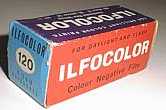 The
32 ASA negative roll film is now called Ilfocolor, available
in 120, 620 and 127 roll-film and 20 exposure 35mm. The picture
shows a 120 roll film, price 10/9d (54p) excl. processing, with
an expiry date January 1964. En-prints from Ilfocolor cost 1/6d
each (7.5p) or 1/3d each (6p) for 2 to 4 prints or 1/- each (5p)
for 5 prints or more from the same negative. The
32 ASA negative roll film is now called Ilfocolor, available
in 120, 620 and 127 roll-film and 20 exposure 35mm. The picture
shows a 120 roll film, price 10/9d (54p) excl. processing, with
an expiry date January 1964. En-prints from Ilfocolor cost 1/6d
each (7.5p) or 1/3d each (6p) for 2 to 4 prints or 1/- each (5p)
for 5 prints or more from the same negative.A 20exposure 35mm Ilfocolor cost 22s/2d (£1.11p). Negatives are card mounted and colour 'contact' prints (in fact made by projection printing - see letter from Ilford's R.B.Matthews in Colour Photography magazine, May 1963) were supplied with the processed film at no extra charge, to assist with print selection. To read about Ilford's processing of Ilfocolor, click here. To read general information about Ilford's colour films during the period 1948-1968, click here. |
|||
|
Click on the Ilfocolor print envelope alongside to see an enlarged version and its inside / rear text. |
|||
|
Les Lester, now living in Melbourne,
Australia, e-mailed (June 2008) to say that during the period
c1960-64 he worked for Ilford Ltd at Bower House (a Georgian
mansion near Romford, Essex) where Ilford had a research and
development (R&D) centre. The mansion was eventually taken
over by another company but Les couldn't recall who (?; In March
2014 this mystery was solved by Catherine Beale, who told me
it was taken over by the Ford Motor Company, Ltd, for training
purposes associated with their Dagenham works nearby. Catherine
is [2014] involved with the architectural refurbishment of Bower
House). Sharon Ellis has sent me a photograph
of some of the Selo
Factory employees in the 1960s. |
|||
|
|
From the beginning of 1963 Ilford made pre-packed colour processing chemicals and technical assistance generally available to all commercial photo-finishers, and by 1964 a number of independent finishers were processing Ilfocolor roll films. Ilford reminded photographers that the earlier 10ASA Ilfachrome would only be accepted for processing until December 31st 1963. By that date the last batch made would be 1year over the date of expiry on the carton. Ilfochrome prints from 35mm transparencies no longer available due to 'heavy demand' for Ilfocolor prints. Prints from Ilfocolor half-frame negatives now (Sept. 1963) available; 3.5" x 5" cost 2s (10p). |
||
|
CIBA AG, Switzerland, approach Ilford with a buy-out offer.
The CIBA group comprised: There was no take-over by Ciba
until 1969 but there began commercial co-operation between Ciba
and Ilford to develop Ciba's dye-bleach print material (for making
prints directly from colour transparencies). Other group products also had
'CIL' at the beginning of their name e.g CILMATIC cameras
which had much in common with the Dacora Sportsman range but
were only sold in mainland Europe. |
|||
|
Paul says "I am particularly pleased with the photo of the Ilfocolor prints being checked at the Basildon colour laboratories. What a shame there are no pictures of the (automatic) printers. One little scrap in the article is the mention of the British Xylonite (BX) factory at Manningtree which, despite the magazine being about Essex, is actually in Brantham, which is just across the River Stour in Suffolk. You mention the Margaret Thatcher connection with this factory (see 1946, above). My late mother-in-law worked for BX at Brantham in the laboratories when she first left school, before WW2, but had left long before Mrs Thatcher ever worked there." |
|||
|
Formolith materials were designed for use in Graphic Arts, and provided the highest possible contrast images. They provided "fine, clean and well-defined lines in a dense back-ground". For dimensional stability of the image relative to the original, Formolith was "available on two thicknesses of polyester base and also on glass where the last word in 'size holding' is necessary". By 1963, Formolith materials were finding an ever increasing application in the manufacture of printed circuits. |
|||
|
To view the Guide as a pdf file, click here or on the image. Made available by Paul Godfrey. |
|||
 Ilford Exposure Guide for Ilfocolor 32
print, and Ilfochrome 32 slide, films. It is dated L63, hence
December 1963 (same as above). It contains simple information
on using flash indoors and outdoors for Sporti
camera owners and more complex information on daylight and flash
exposures for owners of cameras like the Sportsman. Ilford Exposure Guide for Ilfocolor 32
print, and Ilfochrome 32 slide, films. It is dated L63, hence
December 1963 (same as above). It contains simple information
on using flash indoors and outdoors for Sporti
camera owners and more complex information on daylight and flash
exposures for owners of cameras like the Sportsman.To view the Guide as a pdf file, click here or on the image. Made available by Paul Godfrey. Paul noticed that, strangely, Ilford advised the use of clear flash bulbs when using Ilfocolor print film indoors, presumably feeling they could correct the resulting warm cast at the printing stage. Why they decided to make printing more difficult, rather than advising the use of the correct colour temperature blue bulbs (as, indeed, they do for Ilfochrome and also Ilfocolor when using flash outdoors) is intriguing. |
|||
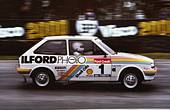 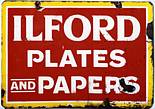 Click
here, to read some anecdotes and view
some images supplied by Peter Pearse. Click
here, to read some anecdotes and view
some images supplied by Peter Pearse.Peter joined Ilford Ltd in 1963, working in the Basildon colour unit before moving into distribution, then export and finally working in the London office under Jeff Vickers (Jeff became Ilford General Manager in 1975). Peter took early retirement in 1986. |
|||
|
In july 2012 I heard from Alan
Waller who worked for Ilford from 1955 to 2000. His father
also worked for Ilford from 1931 to 1972. Alan described the
Ilfoprint system as follows: "The Ilfoprint enlarging papers proved useful in applications where speed of obtaining a print was more important than its permanence. The paper had the developing agent (hydroquinone) in the emulsion. The processor contained an activator - a solution of sodium hydroxide - and a stabiliser. The stabiliser was ammonium thiocyanate which converted the undeveloped silver halide to a light-stable silver complex. Prints lasted for weeks or months but the stabiliser remaining in the unfixed, unwashed print tended to bleach the image. They could be made permanent with a 20min soak in fixer and a 30min wash. Ilfoprint was largely superseded in the darkroom by Ilfospeed which offered fast-enough processing and far superior image quality." "The most successful and longest-running application for Ilfoprint was Teletransmission Paper which was designed especially for the Muirhead K300 automatic facsimile receiver. This machine was extensively used by newspapers and agencies such as Associated Press. It was primarily for press photographers and delivered a b&w damp dry stabilised print in about 40sec." |
|||
|
|
Ilford has a number of wholly
owned subsidiaries in the UK (incl. Britannia Works Co. Ltd.
whose main business is wholesale black and white photo' finishing
and the manufacturer of chemicals, including ' hypo') as well
as 50% interests in some other companies (incl. Butlins Photographic
Services Ltd. which operate photographic services at
seven holiday camps, two hotels and a beach outlet). Ilford has some 22,000 authorised dealers, including branches of multiples, and some 2,000 dealers' agents. |
||
|
See 1965 entry below for further information on this series of books. |
|||
|
Harold D.J.Cole, F.R.P.S; more usually known as David Cole, became the Royal Photographic Society (R.P.S) President, having joined in 1930 and since served on the R.P.S Council and various Committees. David Cole joined the Ilford Research Laboratory in 1928 and subsequently worked under Dr.Olaf Bloch, himself a Past-President of the R.P.S. By 1964 David Cole was responsible for all of Ilford's photographic advertising work, exhibitions and displays. |
|||
|
|
HP4 roll film first became
available alongside HP3
(not replacing it until the end of 1969) in 120 and 127 roll
film sizes, cost 4/6d (23p). HP4 in 35mm film size became available
during 1966. |
||
| A 36 page booklet, "Ilford FP3, Film of Many Faces" offered free to applicants sending one empty FP3 carton. Authored by Sandy Brownstone of Ilford's Technical Publications Department (ref: Aug 18th AP magazine). | |||
|
Colorprint must have subsequently (probably quite soon afterwards) also have become available in roll film sizes, see 1968 entry re:Super Colorprint. Its possible the contact prints
were made on a machine produced by Ilford's subsidiary, Kennedy
Instruments (manufacturers of the Advocate
camera). It seems Walter Kennedy had been developing a machine
for the high speed printing of Ilford Colour transparencies since
the late 1950s. Specially made for Ilford Ltd, it was considered
too complex to manufacture and distribute to independent photofinishers. |
|||
|
Super Colorslide and Colorprint were also introduced in ' Rapid' cassettes. |
|||
|
Other books still in planning
in 1965 were: "Flowering Bulbs, Corms and Tubers",
"Flowering Shrubs and Trees", "Greenhouse Plants",
"Herbacious Plants 2", "Annuals and Biennials"
and "Roses", with a further volume planned, being "Gardens
in Colour". |
|||
|
|
Ciba and ICI acquire all outstanding shares of Ilford | ||
|
A year previous, Ilford had started
supplying their film in the Agfa Rapid cassette system, for the
Sportina Rapid and similar
cameras. Agfa had re-released this cassette system to counter
Kodak's 126 Instamatic cartridge system and Ilford initially
supported Agfa in this 'format war'. But, by Spring 1966, Ilford
decided to 'back both horses'. This extract from Camera Magazine
for March 1966 (Editor's Notebook) entitled "Rapid Colour"
explains: |
|||
|
HP4 sheet film is believed to have become available
in autumn 1966 (Ref: notes from Michael Talbert).
For some pictures relating to HP4 sheet film, all sent by Michael Talbert, see here. |
|||
|
In the book 'Silver by the Ton' (see book title above, before the start of this chronology) the 1966 Monopolies Commission Report is blamed for having done more harm to the Ilford Company's finances than two World Wars! George Utley has researched this item and offers
the following explanation: The report concluded that Kodak did have a monopoly, but that this was not against the public interest. The Board of Trade used the report to negotiate with Kodak a voluntary 12.5% reduction in wholesale prices and unrestricted retail distribution. The report also cited processing-inclusive prices as anti-competitive following complaints by independent labs, and recommended reducing tariffs and eliminating all obligatory inclusion of processing in prices. The adoption of these recommendations plus Kodak's price drops, prompted Ilford to drastically lower its colour film prices to the point that they eventually abandoned colour film altogether. The Monopolies Commission report gets cited as an example of unintended consequences, in that it consolidated Kodak's colour film monopoly instead of addressing it. However reading between the lines, the report seems to have concluded that Kodak's monopoly was inevitable, and the best the Board of Trade could hope for was to negotiate a price cut and introduce foreign competition. Ilford had failed to compete effectively even with protection and the British government was reluctant to continue protecting Ilford if to do so meant higher consumer prices, especially considering that by 1966 all of Ilford's colour films were being made in Switzerland. References: |
|||
| In Spring 1966 (Photography Today catalogue), HPS 120 & 620 roll film was priced 4s.10d (24p), while FP3 & HP3 cost 4s 2d (21p). 36 exposure 35mm b&w (not HPS but incl. Pan F) all cost 7s.5d (37p). | |||
| Although Selochrome Orthochromatic roll film is belived to have been phased out in favour of Selochrome Panchromatic in 1959, these two leaflets, one dated December 1965 and the other dated November 1966, suggest that reference to Selochrome roll film being Panchromatic continued until post-December 1965. By November 1966 the qualification Panchromatic was dropped as being unnecessary, since all Selochrome film was, by then, Panchromatic. | |||
|
|
In May, 7th reprint of the 5th Edition of the 'Ilford Manual of Photography' published (see also, 1958 entry). | ||
| From June to August, Ilford were promoting (in a sexist strip-tease type advert) their Hyfin developer (ultra-fine grain, high acutance and increased film speed) by offering a free 300cc trial pack (sufficient to develop one film) with every purchase of the 'new' 20 exposure cassette of Pan F (50ASA but increased by Hyfin to 80ASA). Recommended retail price 5s.10d (29p). The 20 exposure length (40 exposures with half-frame) was recommended as a 'convenient length for the weekend'. | |||
| Ilford Ilfobrom
Paper introduced. Ilfobrom Glossy became available from February 6th and other surfaces from April 17th (Ref: Photography magazine, April 1967). Six contrast grades numbed IB 0 to IB 5. Grades 0 to 4 all with the same speed, while Grade 5 has half that speed. Codes for the new paper are IB followed by the grade number and P for single-weight and K for double-weight. Thus IB 1 P means Ilfobrom single-weight glossy, grade 1. Other paper surfaces have the codes 5=matt, 24=semi-matt, 26=velvet stipple and 27=velvet lustre. In November, Ilford launched their Ilfobrom Tri-Pack, containing 10 sheets of wholeplate paper (6½" x 8½" i.e. 16.5cm x 21.6cm) of each of the three popular grades: 1, 2 & 3. The paper was double weight, with a velevt stipple finish. The Tri-Pack was offered for only a limited period at the special price of 15s.6d (78p) a saving of 3s.3d (16p). Marston & Heard purchased all the remaining stock of Ilford glossy bromide and began selling it at roughly 30% discount through their 'Amateur Photographer' adverts. |
|||
|
To view the booklet as a pdf
file, click here
or on the image alongside. Available by courtesy of David Muggleton. |
|||
| Film prices were
volatile in 1967. In AP for 26th April, Ilford announced that
FP3 would now "cost no more than 'ordinary' film",
with roll film down in price from 4s.3d (21p) to 3s.10d (19p).
FP3 35mm prices (unchanged ?) were 5s.10d for 20exp (29p) and
7s.7d for 36exp (38p). HP3 120, 127 & 620 roll film cost
4s.3d (21p), 35mm 20 exp cost 5s.10d (29p), 36exp cost 7s.7d
(38p) and 36exp refills cost 4s.6d (22.5p). BUT, in AP's 'News of the Week' for 30th August there was an announcement of new prices for other Ilford black & white roll & 35mm films, necessitated by the increased price of silver. Prices were increased by just less than 10%. Selochrome 120 roll film now 4s/3d (21p), 126 Instant cartridge 4s/9d (24p), 36-exp 35mm HP4 cassette 8s/3d (41p). The 10 sheet pack of 8x10inch Ilfobrom single weight paper, formerly costing 7s/5d (37p) now increased to 8s (40p). Ilford were not alone in needing to adjust film prices. Kodak Ltd. announced (AP 13th Sept) that, owing to the cost of silver, the price of their b&w films was being increased by around 10% in mid-September and its general purpose photographic papers would follow suit in mid-November. |
|||
| Amateur Photographer for 26th April 1967 announced the retirement of Mr Sydney Thomas Ferris, a director of Ilford Ltd "and many subsidiary and associated companies" after 54 years service at the age of 68. "During the whole of his 54 years he was absent only 5 days through illness - 3 days in 1916 and 2 days in 1938. | |||
|
|
In February 1968,
Ilford announced their spring and summer marketing plans for
the year (AP magazine, 21st February; News of the Week). These
were: Following the recommendations of the Monopolies Commission, Ilford colour films to be made available at prices exclusive of processing charges. The range of colour films to be extended to include 120 and 127 roll film size Super Colorprint, alongside the 35mm and 126 films that became available during early 1967. The unique 'Pocket Print' return presentation, which proved popular when trialled with 126 Super Colorprint film during 1967, to be offered in an improved form with all sizes of Ilford colour negative film from May. The processing of all Ilford's colour films, negative and reversal (transparency slide) to be carried out at the Basildon laboratories, Essex. A new, high quality, general purpose black & white film to be launched (FP4, see below). A new range of 126 catridge cameras to be launched, including a complete outfit at less than £5. |
||
|
In May 1968, Ilford FP4 introduced,
replacing FP3 roll and 35mm film. "Fine Grain, High Speed,
Panchromatic, Backed" (but see 1955 slot above; FP4 was
a plate emulsion name 13 years previous, though undoubtedly NOT
the same emulsion as in 1968). By July, Ilford were offering a free 20 page booklet entitled "Ilford FP4" to amateur photographers "wishing to make the best use of the fine qualities of this new emulsion". It was obtainable by writing to Mike Williams, Customer Services, Ilford Ltd, Ilford, Essex. This booklet (see left) updated the booklet "Ilford FP3, Film of Many Faces" offered in 1965. It is dated March 1968. My thanks to Howard Powne who sent me a copy (in April 2014) from Australia. To view it as a pdf file, click the image or here. |
|||
|
To download this Ilford Technical Guide to FP4, click on the image or here. |
|||
|
"Cheaper Colour" was a headline in the News Desk section
of Photography magazine for July 1968. The item read: Summer time "2 for the price of 1". Ilford Super Colorprint and Ilford Colorslide offered in twin packs of 126, 120, 127 and 20exp 35mm. The Super Colorprint cost 5/- (25p) for the twin pack (processing extra) while the Colorslide cost 8/9d (44p) for the twin pack (processing extra). Even with processing, Ilford calculated that your 40 slides would cost less than 7d (3p) each. I understand from Tristan Brittain-Dissont, Archivist for the Tony Hancock Appreciation Society, that comedian Tony Hancock made an advert at this time for Ilford Colour Film. Currently (2017) no complete version is available, but any one who can help to unearth a copy is asked to be in touch. A truncated black & white version, courtesy of Tristan, can be viewed here (WMV Windows Video format). All colour processing now carried
out at the company's modern laboratories at Basildon, Essex. |
|||
|
More can be read about the Ilfomatic camera range by clicking here or on the camera image. |
|||
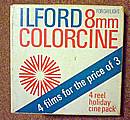 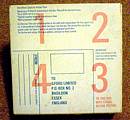 The
Ilford Holiday Cine Pack was another summer time offer, being
4 Ilford 8mm daylight bced Colorcine films for the price of 3.
The pack cost 39/9d (£1.99p) plus processing at 33/- (£1.65p),
giving a total saving of 24/3d (£1.21p). Colorcine speed
was 25ASA = 15DIN. The
Ilford Holiday Cine Pack was another summer time offer, being
4 Ilford 8mm daylight bced Colorcine films for the price of 3.
The pack cost 39/9d (£1.99p) plus processing at 33/- (£1.65p),
giving a total saving of 24/3d (£1.21p). Colorcine speed
was 25ASA = 15DIN.The four 50ft films were returned spliced together on a 'free' 200ft reel in a dustproof plastic case. To ensure the individual films were spliced in the right order, customers had to return the exposed reels in the original box, with the 1st film in the place numbered 1, the 2nd in the place numbered 2 etc. The illustrated film box has a 'use by' date of March 1969. |
|||
  From end of June,
Ilford began sending a copy of a 16 page magazine called 'Colornews'
to all colour film users with their processed films. The magazine
was to contain hints & tips relevant to its season of publication,
aimed at helping Ilford colour film users get more fun from their
hobby. Also to be included was a supplement leaflet 'What's on
and Where', providing up to date information on events of photographic
interest. From end of June,
Ilford began sending a copy of a 16 page magazine called 'Colornews'
to all colour film users with their processed films. The magazine
was to contain hints & tips relevant to its season of publication,
aimed at helping Ilford colour film users get more fun from their
hobby. Also to be included was a supplement leaflet 'What's on
and Where', providing up to date information on events of photographic
interest.Ilford colour cine film users were to receive a "Movie Supplement", published twice a year - Colorcine News. To view a pdf of Issue 3 of Colornews, click here or the first image. To view a pdf of Issue 1 of Colorcine News, click here or the second image. My thanks to Paul Godfrey for these pdfs. |
|||
|
The Selochrome Pan roll film illustrated is a size 620, 160ASA, with an expiry date of April 1971, from or near the last batch.
A 120 size Selochrome pan(chromatic)
roll film carton, film expiry date December 1969.
A twin-pack of 127 size roll film, with an expiry date of March 1969. This picture, together with another
that can be viewed here, |
|||
|
A Flat Film (Sheet Film) data
sheet for March 1968. |
|||
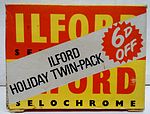  The formal change to a white carton
design (as above) took place around the time of the sunburst
symbol being introduced, in 1965. But the Twin-Pack "Save
6d" (2.5p) Selochrome Pan carton shown here (courtesy of
Charlie Kamerman) is dated to be developed before February 1969,
suggesting maybe a 1966-67 manufacturing date. Possibly the stock
of old cartons was used up subsequent to 1965 by bundling them
in this "Ilford Holiday Twin-Pack, Save 6d" promotion.
The speed rating for minimum exposure is given as 160ASA (ISO). The formal change to a white carton
design (as above) took place around the time of the sunburst
symbol being introduced, in 1965. But the Twin-Pack "Save
6d" (2.5p) Selochrome Pan carton shown here (courtesy of
Charlie Kamerman) is dated to be developed before February 1969,
suggesting maybe a 1966-67 manufacturing date. Possibly the stock
of old cartons was used up subsequent to 1965 by bundling them
in this "Ilford Holiday Twin-Pack, Save 6d" promotion.
The speed rating for minimum exposure is given as 160ASA (ISO). |
|||
  A
single 127 size roll film of Selochrome Panchromatic, still in
the pre-1965 colours. This film is dated for processing before
July 1968, suggesting it was made around 1965, perhaps just before
the new carton colours and sunburst symbol were unveiled. A
single 127 size roll film of Selochrome Panchromatic, still in
the pre-1965 colours. This film is dated for processing before
July 1968, suggesting it was made around 1965, perhaps just before
the new carton colours and sunburst symbol were unveiled. |
|||
| At the end of 1968,
Ilford were selling the following black & white processing
chemicals. They were described briefly in the leaflet dated March
1968 that can be downloaded
here. ID 11 ~ The standard fine grain developer...... (the same formula is used in Kodak's D76 and in the May & Baker's developer, '320'; Ref V.Blackman column, AP, 7th August 1968). Dowload a July 1959 ID-11 leaflet here. Microphen ~ Fine grain and a speed increase. Dowload an October 1977 Microphen leaflet here. Hyfin ~ A high acutance developer.... Monophen ~ Combines developing and fixing into one operation.... PQ Universal ~ A paper developer also suitable for developing roll film. Bromophen ~ Really excellent results with Ilfobrom paper, though also able to develop roll films. Ilfofix ~ An acid hardening fixer... Hypam ~ A high-speed fixer for films and paper. Can become a hardening fixer by the addition of Hypam Hardener. |
|||
| A leaflet entitled
"Ilford Darkroom Safelights", printed for Ilford
Limited, Ilford, Essex in October 1968 (J.68). Sent to me by
Roger Gittins of the Mobberley Village Society. To view the leaflet, click here. |
|||
| HPS sheet film phased out by March 1968 | |||
|
|
From the start of 1969 (as announced November 1968 - see AP magazine, 20th Nov, News of the Week), Ilford ceased applying their name to amateur colour films. Ilford Ltd changed their policy to only supplying colour films to distributors and organisations able to market the material under their own private label. At this time, 25% of Ilford's colour film output was going to the USA. Ilford intended to continue with colour film R&D but decided on this new marketing policy as their colour film had not returned a healthy profit during the previous 20years (1948 launch of Ilford's first colour film, Colour FIlm D). | ||
| Ilford's high speed
(800ASA) HPS roll and 35mm film are phased out. Thereafter,
HPS is only available as narrow gauge cine film stock - perhaps
for the next two years (?). Ilford believed that HP4, with some push-processing, was capable of replacing HPS as a high speed film (ref: SLR Camera magazine for July 1968, "Letters to the Editor"). |
|||
|
Ciba acquires all of ICI's shares in ILFORD to become sole owner of ILFORD Limited, six years after their initial approach. A year later Ciba merges with JR Geigy to become Ciba-Geigy. Introduction of Cibrachrome colour reversal printing paper and chemistry, a product developed by Ciba Photochemie of Switzerland, based on the silver-dye-bleach principle originally proposed in 1905 by the Austrian Karl Schnitzel. Over the following years it was further developed by Ciba and Ilford into a world renowned 'industry standard' product for high permanence richly saturated prints from transparencies. On 31st Dec 1969 Ilford ceased
supply of the Ilfomatic 126 cameras and camera outfits, ending
the sale of all Ilford's amateur camera products. Ilford FP4 Challenge Cup print competition, judged (late November / early December) by George Hughes (AP Features Editor), Photo-Trade World Editor Roy Mathers and Ilford's Bill Risden. The Mobberley workforce had grown to around 550. |
|||
| Multigrade printing paper again withdrawn from sale, April 1969. | |||
| David Miszewski, in Poland, says "In July 1969,
Ilford signed a license agreement with the Polish FOTON Photochemical
Works, who were already manufacturing light sensitive materials
(photographic films, papers, radiology x-ray films etc.). The technology know-how from Ilford resulted in Foton building a new factory and sending a technical team to the Ilford factory for training. Ilford’s HP4 was also licensed, and was then produced and sold in Poland as Fotopan HL". David believes Pan F was also licensed and was produced at Foton under the name Fotopan FF, but there are no records to confirm this theory. Also Ilfobrom was licensed, resulting in the fantastic Fotonbrom enlarging papers. |
|||
|
|
|||
|
The 600cc pack illustrated alongside
has the date of August 1974 (H.74). It contains two heat sealed
polythene satchets, one considerably larger than the other. |
|||
 "Newsreel" in Practical Photography
magazine, August 1969, reports "ILFORD ON THE MOON". "Newsreel" in Practical Photography
magazine, August 1969, reports "ILFORD ON THE MOON"."As with all earlier missions, Ilford film will be on board Apollo 11 when it attempts its moon landing. The film to be used will be Ilford G5 and K2 Nuclear Research emulsions produced at the Research Laboratory of Ilford Limited, Ilford, Essex. The job of the film is to measure the radiation exposure of the three astronauts. The film will then be analysed and the number of particle tracks will give an indication of the total radiation to which each astronaut has been exposed". On July 20, 1969, lunar module Eagle landed on the Moon, carrying Neil Armstrong and Buzz Aldrin. Michael Collins orbited above. Armstrong and Aldrin spent a day on the Moon before returning to Earth. |
|||
|
|
First Queen's Award to Industry (& see 1975) | ||
| Ciba merges with JR Geigy becoming Ciba-Geigy. | |||
| Ilford's Chief Executive, Dr A J O Axford, announces planned £4m additions to the Brentwood, Essex, factory; a new film manufacturing block, a quality control laboratory, additional film packing areas and general site support services. Expected to be 'on-line' within 2 years. I also understand there was a large R&D department at or near this site, at Warley, Brentwood. | |||
| Elmo cine equipment
no longer distributed by Ilford. Transferred to C.Z.Scientific
Instruments Ltd, 93/97 New Canvendish St, London, W1A 2AR. Any servicing requirements of previously sold Ilford-Elmo equipment also handled in future by C.Z.Scientific. |
|||
|
All Ilford colour film and paper materials now discontinued except for Cibachrome. Martin Hadden has emailed to tell me: |
|||
| Ilford Witness camera for sale secondhand in the AP magazine for 21st January at Campkins Camera Centre Ltd, New Bond Street, London, priced £27.10s (£27.50p) with f1.9 Dallmeyer & including case; p&p extra. | |||
|
|
In April, Focal Press publish the 6th edition of the 'The Ilford Manual of Photography', but called 'The Manual of Photography'. It was reprinted in December '71, September '72, September '73 and November '75. Click the link and / or see entries for the years 1890 and 1958 for the prior history. Also, see year 2000 entry for current edition. (Ref: D.M). | ||
|
|
Ilford 220 FP4 was available in 5 roll professional packs by either December 1971 (date of printing of the leaflet enclosed with the film pack shown left) or more likely March 1972 (the date on the box itself). The film within the box had an expiry date of January 1978, so probably packaged around 1975. By 1982, Ilford 220 film was available both as FP4 and HP5 versions (see below). But 220 film never seemed to 'catch on' to any great extent and by 2009 the availability of 220 film (in the UK at least) seems virtually zero. |
||
|
|
To download an Ilfofix instruction leaflet, dated 1972, click here. ILFORD Ltd are a CIBA-GEIGY company (since 1970). Ilfofix was a hardening fixer, slower acting than Ilford's Hypam. | ||
|
Michael Talbert comments "Cilcolor
first appeared in the BJPA for 1974, which covers 1972–73.
The film is likely to have been ire-packaged (Konica) Sakuracolor
N100 (100 ASA) colour negative film for C-22 processing. The
1976 BJPA describes Cilcolor as a C-22 process film, while Sakuracolor
II (note: Type II by 1976) is described as process C-41". |
|||
|
|
Bob Chaffee (see 197, below) has sent me a series
of images of the Ilford Woodman Road facility in Brentwood, Essex,
taken in 1973. Click here
to view Bob's images. See also, images relating to the Selo Factory during earlier times, as sent to me by Sharon Ellis. Another picture provided by Bob Chaffee is of the Ilford facility in Paramus, New Jersey, USA, also taken in 1973. |
||
| Mike Plumb has e-mailed (May 2017) to tell me of
his time spent at the Selo Factory on Woodman Road, Brentford,
working for a gentleman named Eric Skinner in the Cine Testing
Dept. Of particular interest is that Mike worked on the EVR (Electronic Video Recording) system that was developed by CBS in the USA and first announced in October 1967. CBS commercialised EVR at the end of the 1960s with a public demonstration in 1969. A 14minute YouTube video of an early marketing demonstration by CBS can be viewed here. EVR was a mid-way technology between the conventional use of photographic cine film optically projected onto a screen and the later magnetic video tape systems like Betamax and VHS. The EVR system used photographic film to record moving subjects, much as in a cine camera, but playback was by electronic scanning of the sequence of photographic images to enable them to be sent into the aerial input of a conventional TV and so viewed on a TV screen. Originally, the CBS EVR system was used with monochrome film and the film had a magnetic sound stripe running the length of the cine sequence. In this arrangement, a 17.5mm wide twin-track film could accomodate two parallel 'movies', each of which could be viewed entirely independently or the user could choose to switch between playing one movie or the other at any time (CBS claimed this as a possible marketing tool enabling two options to be compared). The film was electronically sent to the TV using a special 'player' (like a later videotape player) that auto-loaded the EVR from a 7" (178mm) cartridge 'reel' and auto-rewound it again before the 'reel' was removed from the player, much as with later videotapes. Still frames could be shown without any visual 'noise' affecting the picture, and then the audio was completely silent, enabling a still image to be easily talked over by e.g. a lecturer. CBS retained North American rights and formed the EVR Partnership for the rest of the world. Members of the EVR Partnership with CBS were Imperial Chemical Industries of the UK and Ciba-Geigy, the Swiss chemicals firm who (as Ciba) had become owners of Ilford in 1969, before Ciba combined with J.R.Geigy to form Ciba-Geigy in 1970. Work continued on EVR into the 1970s, by which time the original twin monochrome film tracks were being used in unison to enable full colour (with sound) TV playback of (commercially) pre-recorded movies. One track was used for luminance information and the other was encoded for chrominance. These combined to produce full colour images. CBS withdrew from the consortium at the end of 1971 but Japanese 'player' manufacturers, plus ICI and Ciba-Geigy, continued to market the system until the end of 1974 and some deals were done in 1975. Mike Plum recalls the system being popular on oil rigs to enable film viewing by workers. At that stage of development Mike recalls "it started out as 40mm wide (photographic colour) film that had six thin magnetic strips for sound. The 40mm film was subsequently slit into strips". |
|||
|
|
Ilford introduce Ilfospeed range of resin coated (RC) (sometimes known as plastic encapsulated; PE) photographic papers, for speedier processing. | ||
|
|
The Queen's Award for Industry presented to Ilford for the 2nd time on 5th September. Ceremony held at the Mobberley site and award received by Chief Executive & Managing Director Mr T W Parton. The Award recognised Ilford's export sales during 1972-75, which increased by over 50%. In 9 years their export sales value had risen from near £7million to £20million (August 1974). | ||
| Jeff Vickers becomes Ilford General Manager. | |||
| This year saw the last plates coated at the Ilford site. | |||
|
|
The large “2” printed on the end of this Cilcolor film carton is believed to denote 'Cilcolor 2' film, hence likely the second type of Cilcolor film, identical to Sakuracolor II, intended for processing in C-41 chemistry. The British Journal of Photography Annual (BJPA) for 1975 lists the original Cilcolor as being compatible with the Kodak C-22 process (see 1973 above). |
||
| Ilford launch their new 400 ISO HP5 film at Photokina. Initially there was a world shortage of this admirable product. The first batches of HP5 were exclusively in the 35mm format and were only sold in Germany, a country selected because it was (at that time) the most profitable marketplace. HP5 120 roll film was launched in the UK in January 1979, replacing HP4 (Ref: AP, 18th April 1992). | |||
| Cibachrome-A (amateur packs) available in UK from 26th April. Prices quoted in 'Camera User' as 20sheets 10"x8" from £14, 2-litre P-12 chemicals (process 20 off 10"x8") from £11. Photography magazine tested it in their May 1976 issue. | |||
|
Bob Chaffee has sent me series of advertisements for Ilford's X-Ray
materials, dating from 1956 through to 1977 (apart from
1971), which appeared in a leading US Medical Imaging Magazine
named “Radiology”. As Bob comments "it is interesting
to see how advertising evolved over that period". Advertisemenst
for 1978 through to 1980 probably exist but are not available
'on-line'. 1980 is the year Ilford stopped distributing Medical
Imaging Films in the US and also the year Bob moved on to Agfa
Gevaert. |
|||
|
The Ilford Ltd. site in Ilford,
Essex, was closed in February 1976 and administrative activities
transferred to the Basildon site, previously only used for colour
processing, chemicals development and manufacture. Bob Chaffee has sent me an aerial view of the Basildon site during an Open Day on June 12th 1976. Click here to view. Angela Pruss has been in touch to say how this move
was a disappointment ("a horror") to her and many of
her colleagues. Angela was a secretary to various managers on
the old Ilford, Roden Street, site during the early 1970s and
has many fond memories. She speaks of providing comment to the
technical staff on the image quality in new products – "it
was nice to get a break from secretarial work and be involved".
"The large rambling site was lovely to walk round at lunchtimes
and there were many little huts/darkrooms where you could watch
the technicians at work." She did move to Basildon, but
it wasn't the same 'atmosphere' and she left after only a few
months. Now, when she visits Ilford town, she can't look at the
Sainsbury building without fond memories of the Ilford HQ site
where she worked. Tom Borg has e-mailed to tell me about the break-up
of the Ilford site and the relocation of its various facilities.
Tom was employed by Ilford from 1964 to 1995, initially as a
research technician and ending as a Senior Manager, during which
time he led the team which took XP1 from research to manufacture
(1980). Tom recalls that the original Ilford site still (1976)
had the old cottages where the business started, plus an organic
chemistry research building across the road in Roden Street.
Some chemists working there specialised in mercaptans which are
incredibly smelly and led to complaints from bus passengers when
the boffins went home! He also mentions that the Ilford site
hosted an early J.Lyons & Co 'Leo' computer, one of the first in the UK,
to handle payroll. Tom still has some of the germanium diodes
from when the Leo was scrapped and dumped in the carpark. Ian Miller worked at the Ilford Ltd, Selo Works,
Woodman Road, as a graduate Chemical Engineer from 1974 to 1977,
with the job title "Production Scientist". This basically
meant transferring new techniques, that had been the subject
of R&D in the Ramsden Laboratory, Warley, into main stream
production. One of the projects Ian worked on during the hot
summer of 1976, was the initial testing of a novel computer control
system, based around the DEC PDP-11 microprocesor, to control
the emulsion making process. The challenge was to produce film
emulsion capable of large magnification for use in microfiche
production. This was a growing application, enabling the miniaturised
storage of 'main-frame' computer print-out at a time when large
scale magnetic storage ('floppy' disks) was still in its infancy. David Kilcast, Ilford employee from 1972-1981, confirms
Brentwood (the original Selo factory in Woodman Road) & the
newer site referred to as Warley, were completely separate sites.
Warley was about a mile from Woodman Road, located in a less
built up area, close to the Ford European HQ. Taken from the excellent website by Nicholas Middleton "The decision to leave Ilford was taken in 1973. The last plates were coated on 11th November 1975, with the site finally closing in February 1976. Administative functions were relocated to Basildon, and finally consolidated to the current premises in Mobberley, Cheshire when Basildon and Brentwood closed in the 1980s." |
|||
|
|
New HQ formally opened on an industrial estate in Basildon, at Christopher Martin Road, SS14 3ET Tel 0268 27744 | ||
|
|
In January, Focal Press publish the 7th edition of the "The Manual of Photography", previously "The Ilford Manual of Photography". It was reprinted in (at least) November 1978. | ||
| Introduction of
Ilford Ilfospeed Multigrade
Resin Coated (RC) Paper & Filters at Photokina. This version
of Multigrade is much improved on the original (1940) and its
successor (1954). Deservedly popular and part of an integrated
system including processing chemistry and Multigrade enlarger
heads. Further enhanced as Ilfospeed Multigrade II in spring 1984. |
|||
| Following the rationalisation of products and facilities by Ciba-Geigy, Ilford become responsible for marketing their Photographic Group worldwide. | |||
|
|
Near the bottom of the page it reads 'ILFORD Limited, Basildon, England - 1st January 1979' (My thanks to Roy Hammans for information about this booklet). |
||
| HP5 120 roll film was launched in the UK in January 1979, replacing HP4 (Ref: AP, 18th April 1992). | |||
| The book 'Silver by the Ton - A History of Ilford Limited 1879-1979' was published, authored by RJ Hercock and GA Jones, two distinguished Ilford employees. The publishers were McGraw-Hill Book Co (UK) Ltd, Shoppenhangers Rd, Maidenhead, Berks, SL6 2QL; 176 pages illustrated in black & white. The ISBN is 0-07-084525-5. In August 1979 it was priced at £9.95 in hardback | |||
|
An e-mail from Mr John Smith (30th January 2023) informs me that, in the late 1970’s, Ilford sold a machine called an ’Electrogen’ which was used to extract silver from bleach-fix solutions (as used in colour print processing). The Electrogen device regenerated the bleach-fix, enabling its re-use. This machine was actually made by Photographic Silver Recovery (PSR) in Cheshunt (Herts) who made a small range of silver recovery equipment, mainly for use in with medical x-ray processing. A USA trademark application by Ilford (April 1981) and subsequent cancellation (March 1989) can be seen here: https://alter.com/trademarks/electrogen-73305729 John Smith worked at PSR from about 1978 to 1982 and recalls that Jack Coote (see his entries above in 1952, 1953 and 1960) was involved with PSR, though believed to have retired from Ilford by that time. John also mentions Les Mason, a chemist who had been with May & Baker and possibly also with Ilford at some point. |
|||
|
|
Ilford XP1 400 Chromogenic Film first appeared at Photokina, in September. | ||
| The Ilford Group was restructured due to financial losses related to the price of silver. Practical Photography magazine for May 1980 carried a report on the spiralling cost of silver in their 'Gossip Column'. They wrote that "Ilford is just one of the companies looking for ways of using silver more economically and of recovering silver from scrap films and off-cuts. ......the January 1979 price for silver was £3 an ounce (28.3grams); in January 1980 it was £23 an ounce." | |||
| Ilfobrom Galerie paper announced "a new black and white, fibre-based enlarging paper for prints of hitherto unattainable quality." | |||
|
|
Chromogenic XP1 400 35mm film first goes on sale in the UK. It was originally due to be on sale by March 1981, but was bought forward to January 1981. Ilford claimed the rushed release was due to the "tremendous response" received when the film was shown at Photokina (see above), but the decision may have been influenced by the imminent appearance of a rival chromogenic film, Agfapan Vario-XL Professional. The rival film went on sale shortly after XP1 400. A test report in Photography magazine for May 1981 found "..at this time the Ilford rival seems markedly better, whether in its own chemistry (XP 1) or Kodak's (C41)." |
||
| David Kilcast, who worked in R&D at the Brentwood factory site from 1972-81, tells me that the (Selo) Brentwood site was still operating on his departure in 1981, although shutdown plans were then well advanced. | |||
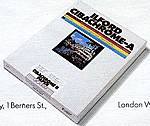 Cibachrome-A 11 (colour prints from colour
transparencies) using Process P-30 chemicals replaces previous
Cibachrome-A & P-12 chemicals. Paper available as CPSA.1K
(de luxe glossy) and CRCA.44M (pearl). Claimed "improved
colour reproduction, improved colour saturation and improved
contrast control characteristics". Kevin MacDonnell attended the press release
at the Tara Hotel in Knightsbride (London). Kevin subsequently
did tests and reported "The improvements are very obvious".
"The recommended processing temperature is 24°C though
by varying the times you can work between 20-29°C. A 3minute
development is followed by a 30sec. rinse. The print is then
bleached, fixed and washed, each step, like the development,
needing 3minutes, making a total processing time of about 12minutes."
"...its easy to tell them (old and new versions) apart.
If it hasn't got a picture on it (the printing paper packs and
bottles of chemicals), its the old material." Cibachrome-A 11 (colour prints from colour
transparencies) using Process P-30 chemicals replaces previous
Cibachrome-A & P-12 chemicals. Paper available as CPSA.1K
(de luxe glossy) and CRCA.44M (pearl). Claimed "improved
colour reproduction, improved colour saturation and improved
contrast control characteristics". Kevin MacDonnell attended the press release
at the Tara Hotel in Knightsbride (London). Kevin subsequently
did tests and reported "The improvements are very obvious".
"The recommended processing temperature is 24°C though
by varying the times you can work between 20-29°C. A 3minute
development is followed by a 30sec. rinse. The print is then
bleached, fixed and washed, each step, like the development,
needing 3minutes, making a total processing time of about 12minutes."
"...its easy to tell them (old and new versions) apart.
If it hasn't got a picture on it (the printing paper packs and
bottles of chemicals), its the old material." |
|||
 An excellent example of the sort of result obtainable from Cibachrome II can be seen on the web page devoted to Ilford memories supplied by Peter Pearse. |
|||
 HP5 Autowinder kit introduced enabling
the processing of a 72 exposure length of film, a frame length
suited to cameras with motor drives. The 'HP5 Autowinder' film
base was made of thin polyester so that the circa 10feet (3m)
72 exposure film length could be accomodated within a standard
36 exposure cassette. HP5 Autowinder kit introduced enabling
the processing of a 72 exposure length of film, a frame length
suited to cameras with motor drives. The 'HP5 Autowinder' film
base was made of thin polyester so that the circa 10feet (3m)
72 exposure film length could be accomodated within a standard
36 exposure cassette.The kit comprised a special processing tank with a stainless steel reel capable of holding the full length of film, loaded from the centre outwards by a hand wound loading device (see illustration). The tank (believed made by Kindermann but marked Ilford) required 400ml of processing solutions. The Autowinder cost £12.25 and the tank with spiral cost £11.95 (Fishwick's 1st Nov 1982 catalogue). |
|||
|
|
Lumière, who were acquired by Ciba in 1962, eventually relinquish their Corporate name and become known as ILFORD France. | ||
| Ilfospeed Multigrade
II paper introduced giving the advantages of 11 distinct grades
from 0 (extra soft) to a genuine grade 5 (extra hard) and easier
exposure control by virtue of the paper speed remaining constant
from grade 0 to 3.5 and requiring just double the exposure for
grades 4 to 5. Image quality, for the first time in a multigrade paper, is equal to the best of uni-grade papers. |
|||
| Ilford return to
the world of colour films (which they abandoned at the start
of 1969) with the re-introduction of an Ilfochrome colour slide
film, named Ifochrome 100. An E6 process compatible film,
priced £1.60 for a 20exp 35mm and £2.08 for a 36exposure.
An Ilfochrome RP6 500cc processing kit (suitable for all E6 reversal
films) was priced at £6.25, sufficient to process eight
24exp or five 36exp films. There is suspicion that this film was being sourced from Konica in Japan. |
|||
| The 'Ilford Contact' system announced, facilitating 'contact' printing 35 mounted 35mm colour slides onto a single 10"x8" sheet of Cibachrome. The system consisted of two plastic frames, one holding 20 slides and the other holding 15, plus a base unit which held the printing paper and also correctly aligned the frames above the paper. The paper was exposed through each frame in turn, the rows of slides in the two frames being offset, such that slides in the second frame priinted into the gap in the rows of slides in the first frame. | |||
| In Fishwick's 1st Nov 1982 catalogue, 220 roll film is available in FP4 and HP5 versions (£2.48 per roll compared to £1.06 for a standard 120). In the same catalogue, only Kodak's Tri-X film is listed as available in 220 roll film (£2.39 a roll). | |||
|
|
CLOSURE of the Ilford Films Selo Works Factory at Woodman Road. Lofty Holloway, an ex employee
of the Woodman Road site, worked there for 4½ years until
around January 1983 when he was made redundant.
|
||
| Amateur Photographer magazine, in its April 2nd 1983 edition, announced "On its way is Multigrade II....". Main improvements were a genuine Grade 5, denser blacks, more neutral image colour, cleaner whites and the addition of a matt surface as well as pearl and glossy. | |||
| Amateur Photographer magazine, in its April 2nd 1983 edition, tested the new Cibachrome II 'prints from slides' paper and its processing chermistry. They concluded that it was marvellous, with more mellow contrast than its predecessor, true and accurate colours, excellent saturation and sharpness that was "very good indeed". To read the test as a downloadable pdf, click here. | |||
| During 1981-83, restructuring of the company occurred resulting in the closure of the Basildon, Essex site and dramatic growth of the Mobberley site. The workforce trebled to 1500. I have received an e-mail mentioning how "the relocation of a large number of staff to the Mobberley site was quite a culture shock for us Essex Girls and Boys. .....huge engineering feat of moving the large manufacturing machines from Essex to Cheshire." | |||
| AP magazine (15th January ~ News Shorts) report Ilford colour print film re-introduced, being Ilfocolor 400ASA, 35mm only. Compatible with the standard C41 process, Ilford claimed fine grain, good exposure latitude and neutral colour bce. A 100ASA version was introduced in the spring of 1983 in 35mm, 110 cartridge and Kodak disc formats. Price of the 400ASA version was (Jessops price, May 1983) £1.54 for a 24exp and £1.98 for a 36exp cassette. The 100 ASA retailed at £1.17p for the 24exp. and £1.50 for the 36exp. 35mm cassette and £1.13 for a 24exp 110 cartridge. | |||
|
|
Apart from the above Ilfocolor
print film, discussion on this webpage confirms that Ilford were still
marketing the 35mm Ilfochrome slide film at this time (from 1982,
see above). These 1984 print and slide films were definitely
being made in Japan by Konishiroku Photo Industry Co. Ltd., also
known as "Konica". The bulk film was packaged in Mobberley,
Cheshire. A 2-page advert by Ilford in Practical Photography, June 1984 issue, stated the advantages of having Ilfochrome 100 processed by Ilford were that a Cibachrome 'contact' sheet print, showing all the slide images, would be supplied and the slides would be returned in sturdy plastic mounts numbered and dated in a slide box designed for easy cross-referencing with the contact sheet. |
||
| The HP5 Autowinder kit (see 1981 entry) is being sold in a small ad. at the rear of AP magazine (24th Nov) by RK Photographic of Ballards Lane, Finchley, London, N3 1LG. £5.99 for the stainless steel 72exp tank & reel, £7.35 the rapid loader and £2.99 for a spare reel. "Only while stocks last". | |||
|
It describes the process steps involved in tank developing your first black & white film. In particular, FP4 film in Infosol 2 developer (4mins), using IN-1 stop bath, Hypam fixer and Ilfotol wetting agent. Further information is given on the use of ID-11, Perceptol and Microphen developers, with Pan F and HP5 film. Microphen is advised for speed up-rating HP5 from 500ASA (6mins) to 800ASA (8.5mins), 1,600ASA (11mins) and 3,200ASA (16mins), all at 20C. To download the leaflet as a pdf file, click here or on the image. |
|||
|
|
Also describes the Ilford processing chemistry available at the time and the suitability of each to the indivual film types. To download this booklet as a pdf, click on the image or here. |
||
|
|
Multigrade made available in a fibre based paper, Multigrade FB. | ||
|
|
Amateur Photographer magazine,
on its NewsView page 42 (March 21st edition) announced that Ilford
had joined the likes of Kodak and Konica by launching "new,
improved" colour emulsions. Ilfocolor HR 100 35mm colour
print film had been available since 1984, but was now joined
by a 120 roll film format. Ilfocolor HR 200 and 400 speed films
were promised to be available "at a later date". The 3 new Ilfochrome (transparency)
films were tested by AP in their 18th April edition. The films
were said to have subtle, neutral colours, making for good, natural,
flesh tones, "so bear these films in mind for portraiture,
especially the ISO 50 and 100. Their low contrast also makes
them quite flattering, if a little 'flat'. But they lack warmth".
The ISO 200 emulsion was felt to be rather grainy for this film
speed. The AP test of these three new Ilfochrome slide films
can be downloaded by clicking the link here. |
||
| Ilford Photo announced (AP April 18th) that they had hand picked over 300 High Street photographic specialists to stock 'everything you need'. They're called Ilford Photo Centres. Later, by 1989, the term 'One-Stop Photo Shops' was being applied. | |||
|
|
Ciba-Geigy sold Ilford to
International Paper,
an American company which also owned Anitec, a US based
manufacturer of graphic arts materials which had taken over GAF
in Binghamton, New York. GAF was previously known as Agfa Ansco
and, previously, Ansco (ref: Bob Chaffee, e-mails of 14th &
16th January 2011). An e-mail from Jan Zlotnick of
West Caldwell, New Jersey, USA, reveals that this was the time
when black & white photography, a branch of photography for
which Ilford were, and remain, product specialists, became recognised
and marketed as an 'art' form in its own right. Jan had the privilege
of working on Ilford's marketing campaign in the lead up to its
sale to International Paper. |
||
| HP5 Plus film introduced (Photo Pro mag, issue 4, Winter1989-90) | |||
|
|
Ilford become Ilford Anitec, see above. | ||
| Ilford announce their Digital Photo Imager (DPI) at the Photokina Exhibition, held in Cologne, Germany, hailing the dawn of the company's venture into the new technology of Digital Imaging. | |||
| First Delta film Delta 400 introduced at Photokina | |||
|
A commemorative FP4 Plus lapel or tie pin, in the (flat) form of a 35mm cassette. Picture courtesy of David Muggleton. |
|||
| Ilfobrom and Ilfobrom Galerie b&w printing papers replaced by new, improved materials called Ilfobrom FB and Ilfobrom Galerie FB. Ilfobrom FB available in 4 equally spaced contrast grades and in a single weight, glossy, finish. Galerie FB is a top quality material ideal for exhibition printing to an archival standard and available in 5 grades as double weight glossy and matt surfaces. Ilfobrom Galerie FB available by mid-1990 and Ilfobrom FB available by the autumn. Prices remain unchanged from the previous equivalent papers. | |||
|
|
Death of Robert Sternberg,
aged 77, a leading designer of the Ilford 'Witness' 35mm camera. XP2 chromogenic film launched in springtime and replaces XP1 400 in 120 roll and 35mm cassettes. Designed for processing in standard C41 colour chemistry. Said to have increased sharpness and a curve shape which is matched to that of Ilford's Multigrade printing paper. Sheet film sizes were intended for release by September. Ilford's 1991 "Photographer of the Year" is Jonathan Knowles, who submitted a black & white portfolio of general still-life material. |
||
|
|
Also announced were two new Ilfocolor
printing papers (see 1993, below). |
||
 Ilford 100 Delta film announced at Photokina. The recommended guide price for a 36exposure cassette
was £3.50p. Ilford 100 Delta film announced at Photokina. The recommended guide price for a 36exposure cassette
was £3.50p.Using Ilford's innpovative shell grain crystals designed to give grain and sharpness comparable with films of a slower speed. Practical Photography magazine (December 1992) commented "There's no doubt that 100 Delta is a lovely film capable of superb results. Prints exhibited fine grain, good tonal range and high sharpness. However, its too early to say whether it will shove the king of medium speed films, Ilford's own FP4 Plus, off its perch. Here are two quite different films that provide high quality results, and which you prefer is down to personal preference. But do give 100 Delta a go - you won't regret it." |
|||
|
|
Ilford release a RA-4 colour negative printing paper with the same ultra-high gloss Melinex ployester base as Cibachrome (Ilfochrome Classic). Named ILFOCOLOR Deluxe, it was (originally) made for both EP-2 and RA-4 colour print processes. John Tinsley tested it for Photo Pro magazine (Aug/Sept 1993, p62) and reported "the paper behaved impeccably, giving good, rich colour with excellent saturation and sharpness. Ilford's new ultra-high gloss Melinex-based colour negative paper brings Cibachrome quality to RA4 hand processing. This is the paper to use for standard commercial photography". It cost £36.46 for 100sheets
of 10"x8" or £43.78p for 50sheets of 12"x16". |
||
| XP1 chromogenic film processing kits (acutance enhancing formula) finally discontinued following the success of XP2 Plus with its full C41 compatibility. | |||
|
|
Ilford launch the "Printasia Digital Imaging System". The system included a Computer, Scanner, Printer and Image Manipulation software but suffered due to the constantly changing technology of computers and peripherals at the time, which led to its demise. Ilford Multigrade IV printing
paper, incorporating a third emulsion component to control print
highlights. Slightly colder base colour and heavier weight. |
||
|
|
Multigrade IV De Luxe resin-coated paper awarded the title "European Black & White Product of the Year 1995-96" by the European Imaging and Sound Awards panel of 13 magazine delegates meeting in Geneva. The citation specifically praised its ability to hold highlight and shadow detail simultaneously. Delta 100 film Improved and suffixed Professional, supersedes the previous emulsion with claimed all-round improved quality, especially in terms of shadow detail and latitude. Availalble in 35mm (24&36exp), 120 roll film and all standard sheet sizes. The following is by courtesy
of George Utley, though he emphasises that the information
really belongs to the accompanying, referenced, websites. |
||
|
|
In April Ilford announced it was moving its administration from London to Mobberley, though technical services, sales & marketing remained in London. Also, the trade counter remained at Tottenham Street, London. XP2 (C41 process) film updated late summer 1996. Made more easily compatible with Multigrade IV paper, the ISO 400 film had more contrast but was intended to give lower contrast with over-exposed negatives and more printing latitude. Sharpness is better. Price remained as for the original XP2 (released 1991) and was available in the same formats, being 35mm, 120 and sheet film. In May 1996 SP815T (see 1995 above) film was released to the consumer market in 35mm cartridges re-rated at ASA 200 and naamed SFX200 (i.e. Special Effects ASA 200). |
||
|
|
International Paper
sells Ilford to Doughty Hanson for £85million. Warmtone Multigrade FB (double weight) paper introduced. |
||
|
|
Doughty Hanson & Co Limited,
as managing partner for a series of limited partners known collectively
as Doughty Hanson & Co Fund 2, acquire a controlling interest
in Ilford Imaging Limited which holds all the shares in Ilford
Limited. Ilford Limited changes its name to ILFORD Imaging
UK Limited with effect from 19th January. Ilford high speed Delta 3200 Professional Film launched at Photokina (10 years after Kodak's Tmax 3200). Ilford stole a march, however, by also introducing their film in the 120 roll format. Ilford's previous ultra high speed film was the little-loved 800ASA HPS, which was removed from the range in the late 1960s. |
||
 Ilford
introduce its third generation Chromogenic film, XP2 Super
Film. Ilford
introduce its third generation Chromogenic film, XP2 Super
Film. |
|||
|
|
Multigrade RC Cooltone paper intoroduced. | ||
|
|
Ilford launch the GALERIE Inkjet Photo Range of paper and media. Focal Press publish the 9th edition of ''The Manual
of Photography', née
'The Ilford Manual of Photography', ISBN:
0240515749, edited by Ralph E. Jacobson, Sidney F. Ray, Norman
R. Axford and Geoffrey G. Attridge. (see year entries for 1890,
1958 and 1971 above, Ref. D.M). |
||
|
(or see the ILFORD PHOTO Press Room) |
|||
|
|
Ilford Imaging celebrates 125 years of photographic
manufacturing, BUT: On 1st September, the
BJP website carried further news: On 27th October, the BJP
website carried further news: On 8th December, the BJP
website carried the news: |
||
|
Pedro Costa, from Porto, Portugal, has written to
tell me that his family previously owned the company that was
Ilford’s distributor in Portugal. Pedro tells me that he worked
with Simon Galley and Howard Hopwood during many Photokina trade
shows, and also with Martin Hadden,
responsible for the Iberian market at the time (a good friend). |
|||
|
|
On 23rd February, the
BJP website carried the GOOD NEWS: Ilford rescued
from extinction A buyer has yet to be found for
the remainder of Ilford Imaging Group, which includes the profitable
Swiss manufacturing site and distribution companies in the USA,
France, Benelux, Switzerland and Australia. Ilford's own web site announced
from Mobberley, February 21st:
Mobberley, 20th June, Ilford Photo published a press release "...the newly emerged organisation is now able to draw breath and assess its current situation." On 29th June issue a 'conversion table' for photographers who want to find an 'Ilford equivalent' paper to their current Kodak paper. Follows Kodak's recent decision to stop making its own b&w papers after a 'dramatic' drop in demand. On 13th July, the BJP website announces Oji Paper, a 130-year old company based in Tokyo, has bought Ilford Imaging Group's Swiss operations for an undisclosed sum. The Swiss business is based around a manufacturing plant in Marly, in which the majority of Ilford's inkjet products are produced - including the Ilford-branded Gallerie and Printasia papers. The move will have little impact on Ilford Photo said Phil Harris, managing director. 'Although the plant in Mobberley, Cheshire, does some contract manufacturing of inkjet products for the Swiss company, we are separate companies. We will manufacture some products for the new owner until the end of this year but don't know what will happen beyond this.' |
||
|
On 6th Sept, Amateur Photographer reported Ilford's reintroduction of its mail-order process-paid b&w developing and printing service. Pre-paid envelopes can be used simply for processing an existing film or can be purchased complete with a b&w film such as Ilford FP4 Plus. The service also accepts b&w single-use cameras such as the Ilford HP5 Plus Single Use Camera. The standard service delivers 6x4in prints with white borders on Ilford Multigrade RC paper which are returned in 'sturdy' storage boxes in an average of five days. It costs £11.74 for the standard process-paid 6x4in service (up to 27 exposures). There is also an option to have images printed in 7x5in format at an extra cost. |
|||
 September
2005 announcement of a single use disposable camera, loaded
with a 27 exposure HP5+ film. More cameras
followed in 2011, 2012 and 2013, see below. September
2005 announcement of a single use disposable camera, loaded
with a 27 exposure HP5+ film. More cameras
followed in 2011, 2012 and 2013, see below. |
|||
|
The dryer takes less than 20 seconds to dry a 10x8ins print, and is the ideal companion to the ILFORD 2150RC processor. The picture alongside is believed to show the 2150RC complete with its dryer module. |
|||
|
|
A new selenium toner, the first of a full range of colour toners from ILFORD Photo, due for marketing in the summer. The high quality formula is straightforward in use and emphasises the versatile tonal range of black-and-white prints. June announcement of an exclusive distribution agreement with WYNIT, Inc. of Syracuse, New York, for distribution of ILFORD black-and-white photo products in the USA and Canada. Arrangements to be complete by 1st July. Subsequently, an American subsidiary, HARMAN technology LLC was set up in New Jersey to handle all market development and technical support in North America.
ILFORD Photo management team since February 2005,
consists of: |
||
|
The catalogue is being distributed to colleges and universities which run photographic courses, as well as to retailers. It is free to users by telephoning 0800 234 6484. Users telephone their order for products and pay an average retail price - carriage is free on orders totalling more than £45, otherwise it is £4.99. The products ordered are sent to the customer's nearest ILFORD Photo participating stockist for collection. Orders placed before 1:00pm should be delivered the next working day. The retailer's margin is paid by way of a monthly credit note. |
|||
|
|
 Re-introduction of Ilford SFX 200 infra-red film. Re-introduction of Ilford SFX 200 infra-red film. |
||
This small clock was a free gift from Ilford at the 'Focus on Imaging' Exhibition, NEC, Birmingham, UK. It was donated to me by Mike Austin of the Riding High Gallery "Gallery and gifts, antiques and collectables. Studio ceramics. Internet Cafe. Museum of cycling memorabilia" in Great Malvern. Mike makes a good cup of coffee, provides interesting conversation and has a fascinating emporium, so do drop in if you are in the area. |
|||
|
Kindly donated by Roger Gittins. |
|||
|
October, HARMAN technology Ltd announced the acquisition of Kentmere Photographic Ltd. HARMAN is keen to stress that the Kentmere brand will remain relatively unchanged. It will continue to offer the same resin coated and fibre based monochrome papers and inkjet products, including Opaljet, whilst employing the same marketing approach. See Kentmere's own web site. ILFOSPEED RC DIGITAL joins ILFORD Galerie FB Digital paper. A medium weight (270g/m2), resin-coated, water resistant photographic paper which produces a neutral image with excellent contrast, sharpness and surface finish. It enables continuous tone b&w images to be printed from digital files prepared from b&w or colour film negatives or positives, prints and digital originals. The results are equal to those seen when using conventional black-and-white printing materials and exposing equipment. |
|||
|
|
HARMAN technology Ltd announced plans to extend its highly popular range of ILFORD PHOTO black and white photochemistry products with a new developer. ILFOSOL 3 is due for official launch in February 2008 and is an enhanced formulation of the one-shot, general-purpose, liquid black and white film developer - ILFOSOL S. | ||
| 'The History of Harman' booklet (see above) was given away again in 2008 at the NEC 'Focus on Imaging' exhibition (end of February) and now includes an entry relevant to the acquisition of Kentmere Photographic Ltd. | |||
| 20th March announcement HARMAN technology to distribute Paterson Photographic products. The new distribution arrangement (which excludes the UK and a limited number of other territories where Paterson will continue to distribute its products as normal) comes into effect for all markets bar the United States from 1st April 2008. The US meanwhile will enjoy all the benefits of the new partnership from 4th June 2008. WYNIT INC, the HARMAN technology distributor will become the exclusive distributor of Paterson photo products for the USA. Speaking of the new partnership, Richard Perry, Managing Director of Paterson Photographic said: “Paterson Photographic and HARMAN have built up a good relationship over the years through our work serving the same customer base. Considering this, and our mutual passion for analogue photography, it makes sense for us to join forces. The move will strengthen and widen our distribution network, whilst offering photographers the benefits of increased product choice and availability.” | |||
| 31st March announcement HARMAN technology appoints a new Canadian distributor. "....highlighting the strength of its on-going commitment to the Canadian market and in order to offer users in the country increased responsiveness and shorter delivery times, HARMAN technology has appointed Amplis Foto (head office in Ontario) to take over its Canadian distribution from 1st April 2008. | |||
| 17th April announcement ILFORD Photo enhances its photo chemistry packaging. "....all items now feature clearer and more visible labelling which means all the information is readily to hand. The bottles also include tactile ribbed sides for better handling and grip, embossed chemical symbols for users with impaired vision and childproof caps for safer storage." | |||
| ILFORD PHOTO to extend its UK Black and White Process and Print Service. In order to offer this extended range of services, HARMAN technology Ltd made considerable investment into new plant and machinery at its Mobberley headquarters. Specifically, the service is now able to offer not only processing and printing but additionally the scanning of film negatives to CD, reprints and enlargements as well as producing real silver gelatine black and white prints from digital files. | |||
|
|
The leaflet compliments the Black & White Process and Print Service announced in 2008, see the item above. |
||
|
|
In May 2010, ILFORD Imaging Switzerland GmbH are bought by Paradigm Global Partners LLP. A petition for compulsory liquidation was served on the company on 20th August and winding-up commenced on 20th October. (Thanks to Gavin Ritchie for the preceeding sentence). | ||
|
|
ILFORD announce a final production run of
ILFOCHROME Classic (née Cibachrome; see 1989 and
1992, above and here)
in response to declining market demand attributed to the expanding
popularity of digital image making. The 'Walker Cameras' designed Harman Titan 4x5 Pinhole camera becomes available from October 2012 in the UK and from December in the 'Rest of World'. |
||
|
|
The 'Walker Cameras' designed Harman Titan 8x10 Pinhole Camera to debut at Photokina, as announced on the Ilford website 5th September. | ||
|
|
Two new disposable black & white cameras announced in January. One is preloaded with XP2 Super film (C41 process) and the other with HP5 Plus film. | ||
| Keith Swan, of
Ilford Lab US, tells me Ilford Lab Direct has been launched to
serve the United States market. The August press release can
be viewed here. ILFORD LAB DIRECT US makes black & white silver image processing and printing (also digital file b&w printing) services available in California and the whole of North America by mail. Steven Brierley, ILFORD Photo Sales Director explained, “It has become more and more difficult for black and white film users to have their films processed and printed to a high quality on real black and white paper. Our Lab based at the HARMAN factory in England has provided a continuous quality service to UK photographers for many years and we are seeing an increased number of enquiries from overseas, including North America. We are excited to announce that built on that success we can now offer the same service from a base in California.” The US website can be viewed here. |
|||
| Early December; An Ilford Press Release announces: ILFORD MULTIGRADE IV FB paper has been the product of choice for creative photographers and printers the world over. Following extensive R&D, significant improvements have been made to the product. It is now renamed ILFORD MULTIGRADE FB CLASSIC. The ILFORD MULTIGRADE FB range has been further enhanced by the addition of the new ILFORD MULTIGRADE FB COOLTONE. This new fibre base product gives a cool image colour with crisp whites and well separated mid tones. These new products join the long established ILFORD MULTIGRADE FB WARMTONE paper, a fibre base paper which produces warm blacks and creamy white tones for luxurious prints. This product has not changed and there are no plans now or in the future to change the MULTIGRADE FB WARMTONE formulation. For the chronology of Multigrade development since 1940, click here. |
|||
|
|
Amateur Photographer
magazine (News pages) for 18th January announced "Ilford
Imaging Switzerland Closes Down Factory". The plant, based
at Marly, is set to lay off 130 staff, having halted production
of their 'heavyweight base' 280gms/m2 inket paper, Ilford Galerie.
Production of a similar paper (Smooth Pearl) is expected to continue
through the facilities of Permajet, in Warwickshire, UK. A worldwide
launch of PerrmaJet's paper was set for 15th January. Buit other interested parties exist and in December 2013 AP had been told "All Scenarios are still open". Please Note: Ilford Imaging Switzerland is an entirely separate company to Ilford Photo in the UK, which is unaffected byt this announcement. |
||
| Ilford have produced a glossy brochure and sent it to local households. It's their plan to reduce the current Mobberley site footprint drastically and replace some of the current buildings with 200 (perhaps more) houses. | |||
|
Marc Payet, formerly (pre-2005) National Sales Manager of the Ilford subsidiary in Melbourne, Australia (see the 1951 chronology entry, above), has sent me a press release from CR Kennedy & Company Pty Ltd., where he has worked as National Sales Manager since CR Kennedy & Company were appointed as Ilford distributors following the 2005 Mount Waverley production site closure. The press release, dated 8th May, states: "WORLD FAMOUS ILFORD BRAND
NOW IN SAFE HANDS AND TO RE-EMERGE AS A LEADER IN THE GLOBAL
IMAGING AND GRAPHICS MARKETS. The full press release can be down-loaded as a pdf file by clicking here. |
|||
|
|
My thanks to Roger Gittins,
at Mobberley, for alerting me that Ilford Photo have been sold
once again. Various newspapers, including the Knutsford Guardian,
carried the following story on 16th September 2015. Regeneration expert LPC Living wanted to build 375 homes on the 40 acre Mobberley site and submitted a planning application to Cheshire East Council, including investment to consolidate Ilford Photo operations onto a smaller 7.5 acre campus within the site. The application was refused and an appeal was made to the planning inspectorate in July 2015. Following a public inquiry in 2016, the appeal was rejected. For further announcements of
the Pemberstone Ventures Ltd purchase, follow these links: |
||
| An interesting YouTube video featuring a presentation by Michael Bain (North American Ilford rep.) given in Dallas, Texas, in early December. | |||
|
|
The Project Team hope to interview as many former employees as possible for their archive, so this important heritage does not get lost. The project will also provide photography workshops in and around Ilford’s Town Centre. It aims to connect local people, both young and old, with the important history of the town of Ilford in Redbridge, which has helped to make accessible the world of photography. Further can be read in the Press Release, downloadable here. An announcement in the 3rd February copy of the Ilford Recorder newspaper can be read here. |
||
|
|
Ron Rendle, left and Bill Forster,
right. Ron photographed the frigate
HMS Mourne (K 261) blowing up after she was hit by a GNAT torpedo
from U-767 on the 15 June 1944. He got his film from "an
old school pal", Robert Patience, who worked at the Selo factory in Brentwood. At this time Ron was serving aboard HMS Bickerton, commanded by Capt Donald G.F.W. Macintyre. When Macintyre heard that Ron had a camera he transferred him from his action station with the depth charges at the stern, to the Bridge, where he would be on hand to photograph the sinking of the ship's next U-boat. Unfortunately, while escorting HMS Nabob and HMS Trumpeter, both the Bickerton and Nabob were struck by torpedoes and the Bickerton was lost. Ron survived, but the money he made from his ship-board photography was in the ship's safe and went down with the ship, along with all of his photographs. |
||
|
|
On 5th December 2018 Harman Technology Ltd announced the ILFORD SIMPLICITY range of convenient processing chemicals. Packaged in sachets "ideal for photographers who want to try processing their own film but have until now been apprehensive about the process and/or may not have required the larger volumes offered in the existing range of bottles or powders". Giles Branthwaite, Sales & Marketing Director, said: “We have listened to customer feedback about how frequently they process film as well as how, when and where they do it. ... these sachets (are) for photographers who are new to film and want the confidence to try home processing as well as more experienced film users who don’t process regularly and therefore don’t want to commit to larger bottles of photo chemicals.” Ilford's Kentmere film range was given new look packaging and new names, though the film iteslf remained unchanged. Kentmere 100 and 400 became officially known as Kentmere PAN 100 and PAN 400 and both remained available as 24 and 36 exposure 135 cassettes as well as bulk length rolls. |
||
|
|
In the year of their 140th anniversary, on 24th October, ILFORD Photo announced new products, Including a 5th Generation ILFORD Multigrade RC Paper and ILFORD Ortho film in 35mm and 120 roll film formats. On the 5th Generation Multigrade, Ilford say "“Improving them was not going to be easy but we wanted to bring the manufacturing in line with the latest emulsion making technology used in our other RC and fibre papers and so we have redesigned the emulsion from the ground up. This project has been in development for 8 years and we are extremely pleased and excited with the final product". (says Giles Branthwaite, Sales & Marketing Director). These new papers have a slightly warmer base tint than their predecessor as well as better, deeper blacks, improved mid-grade spacing for easier printing and more consistent contrast throughout the tonal range. ILFORD Ortho Plus is an orthochromatic black and white film (all other ILFORD and Kentmere films are panchromatic) rated at ISO 80 in natural light and ISO 40 in Tungsten. “Our Ortho film was designed as a technical, high-resolution copy film for negatives and has been available in sheet format for some time. We know photographers want choice and love to try new films and so we have now coated our Ortho emulsion onto an acetate base for 35mm cassettes and 120 rolls. We believe ORTHO PLUS offers superb photographic potential thanks to its fine grain and sharpness and some of the results we have seen are stunning.” (says Giles Branthwaite, Sales & Marketing Director). The blue and green sensitivity of this emulsion enables the film to be handled in deep red safelight conditions making processing and inspection easier. Its lack of red sensitivity also means that reds and oranges are rendered darker than panchromatic films. ILFORD & Paterson film processing starter kit. In collaboration with Paterson, a specialist manufacturer of some of the world’s most popular darkroom products, ILFORD have created a starter kit containing all that is needed to process two rolls of film. Users just need a light tight space and some film! “ILFORD Simplicity chemicals are pre-measured for simple, convenient use and while they can easily be used in most tanks their volumes work perfectly with the Paterson 2-reel Universal Film Development Tank as they hold 600ml of diluted chemicals. Working closely with Paterson we have now created a kit that offers film photographers a convenient and affordable way to start processing their own films.” (says Giles Branthwaite, Sales & Marketing Director). The kit contains: 1 x ILFORD 35mm Film Cassette Opener, 1 x ILFORD Simplicity Film Starter Pack (containing developer, stop bath, fixer and wetting agent), 1 x Paterson Universal Film Tank, 2 x Paterson Super System 4 Reels, 3 x Paterson 600ml Graduates, 1 x Paterson Thermometer, 1 x Paterson Stirrer, 2 x Paterson set of 2 film clips. |
||
|
|
After a 10 week cessation of production due to the Covid19 pandemic, on 18th June 2020 ILFORD posted "We are back! Following the recent easing of the coronavirus lockdown measures here in the UK we are excited to report that life is starting to return to our Mobberley site, with our machines and staff being phased back into operation". | ||
|
|
 Perhaps in late 2021 or early 2022, the ILFORD ILFOCOLOR disposable camera appeared on the UK market. Various websites illustrate and discuss the origins of this camera and its Process C-41 colour negative film, 400 ISO. One such can be read by clicking here. Speculation is that the film, in a 35mm cassette, may be old stock kept fresh in refrigerated store since the demise of analgoue photography. The ability to provide 27 exposures presumably originates from the film being originally intended to provide 24 exposures within a conventional 35mm film camera. In this pre-loaded disposable, no part of the film gets fogged during the film loading process, so the sacrificial film 'leader' provides sufficient extra length for a further 3 exposures. There is a built-in electronic flash for indoors and cloudy days over a 1-3m range. Focus is fixed, optimistically claiming to cover a range 1m to infinity. The front packaging has a small amount of character language script in Japanese. The rear of the packaging states its origin as "Ilford Imaging Europe, GmbH" (see 2014 above), so its not from the UK organisation Harman Technology, who trade under the name ILFORD Photo. The picture alongside was snapped digitally in a branch of Rymans in June 2024. |
||
|
|
Produced entirely in the Harman factory in Mobberley (UK), the Phoenix 200 film is the result of an initiative launched at the heart of the company in 2022. The goal being to design and manufacture a colour negative film offering an alternative to film photography enthusiasts. Harman's Phoenix 200 is distinguished by its visible grain and bright colours, offering a specific artistic rendering. Chemical development follows standard C41 processing. The images produced promise saturated hues with "vigorous greens, pleasant reds and deep blues." Giles Branthwaite, Director of Sales and Marketing at Harman, highlights that revenue generated from this product will contribute to improved formulations, emulsion technology and colour science for future products. The intention is to produce further new Harman colour films, each better than the last. Harman Phoenix 200 colour film will be available at the beginning of December 2023 at the price of €15.49 per 36 exposure cassette (around £13.30). |
||
 |
| This page last modified: 21st September 2024 (previously 29th October 2019) |
 September
1889, a monthly news sheet was introduced called 'Photographic
Scraps'. Harman's first
business manager, whom he appointed in 1889, was John Howson,
a salesman with quiet charm, great originality and considerable
initiative. Immediately on joining, Howson started to write and
publish Photographic Scraps (Ref: Silver by the Ton, p.112).
September
1889, a monthly news sheet was introduced called 'Photographic
Scraps'. Harman's first
business manager, whom he appointed in 1889, was John Howson,
a salesman with quiet charm, great originality and considerable
initiative. Immediately on joining, Howson started to write and
publish Photographic Scraps (Ref: Silver by the Ton, p.112).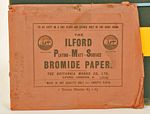

 First
appearance of Ilford Iso-Zenith plates, speed 700 HD originally
= around 50ASA (ISO) in the post-1960 speed rating system.
First
appearance of Ilford Iso-Zenith plates, speed 700 HD originally
= around 50ASA (ISO) in the post-1960 speed rating system.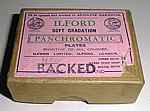
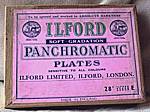
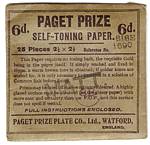
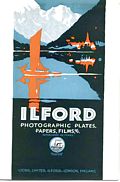

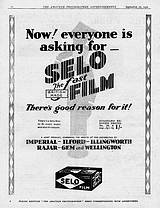

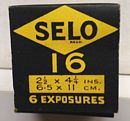
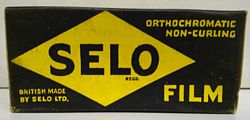 An early 116 size (6 exposures each 2½"x4¼")
roll of Selo Orthochromatic film, dated "Develop Before
July 1933".
An early 116 size (6 exposures each 2½"x4¼")
roll of Selo Orthochromatic film, dated "Develop Before
July 1933". This red & black covered 36 page
booklet is entitled "ILFORD Plates and Films" and bears
Ilford's steamer logo above the words "Ilford Limited, Ilford
London". It is presumed to date to February 1934 from the
B34 footnote on the back cover.
This red & black covered 36 page
booklet is entitled "ILFORD Plates and Films" and bears
Ilford's steamer logo above the words "Ilford Limited, Ilford
London". It is presumed to date to February 1934 from the
B34 footnote on the back cover.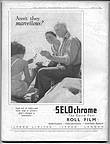
 Ilford
Hypersensitive Panchromatic (HP) 160ASA and Fine Grain
Panchromatic (FP) 28ASA roll films introduced.
Ilford
Hypersensitive Panchromatic (HP) 160ASA and Fine Grain
Panchromatic (FP) 28ASA roll films introduced.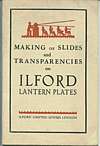 This 32 page 180mm by 120mm booklet explains
techniques for making lantern slides from existing negatives,
by contact or reduction printing. "Of all the fascinating
bypaths of photography it is doubtful whether any gives such
complete satisfaction and permanent pleasure as the making and
exhibition of lantern slides. ...it enables the photographer
to see his pictures at their very best, and to share his pleasure
with a large or small circle of friends. The amateur photographer
with scientific or artistic inclinations.....can producer lantern
lectures of the utmost educational value."
This 32 page 180mm by 120mm booklet explains
techniques for making lantern slides from existing negatives,
by contact or reduction printing. "Of all the fascinating
bypaths of photography it is doubtful whether any gives such
complete satisfaction and permanent pleasure as the making and
exhibition of lantern slides. ...it enables the photographer
to see his pictures at their very best, and to share his pleasure
with a large or small circle of friends. The amateur photographer
with scientific or artistic inclinations.....can producer lantern
lectures of the utmost educational value."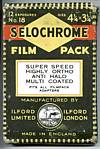 Selochrome 'Super Speed' film pack, containing
12 flat films size 4¼" x 3¼" (Size No.18).
Selochrome 'Super Speed' film pack, containing
12 flat films size 4¼" x 3¼" (Size No.18). A
cardboard box that originally contained 16 quarter plate size
(3¼"x4¼") Ilford Process Plates.
A
cardboard box that originally contained 16 quarter plate size
(3¼"x4¼") Ilford Process Plates.
.jpg)
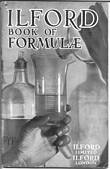
 A
twin pack of Selo films for the
A
twin pack of Selo films for the 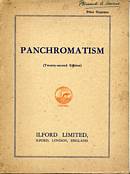
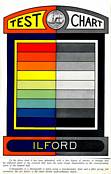 The
22nd edition of 'Panchromatism', price 6d (2.5p) by ILFORD Ltd.
Pictures courtesy of
The
22nd edition of 'Panchromatism', price 6d (2.5p) by ILFORD Ltd.
Pictures courtesy of  (b&w)
panchromatic plate and a filter giving full (colour) correction,
the two halves of the test chart should approx. match.
(b&w)
panchromatic plate and a filter giving full (colour) correction,
the two halves of the test chart should approx. match.
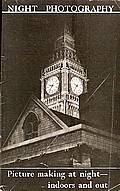
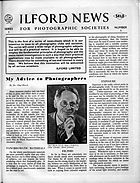
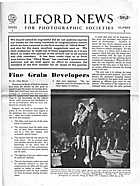
 23rd edition of the 44 page Ilford Ltd
booklet entitled 'Panchromatism', price 6d (2.5p) and dated May
1938, illustrated courtesy of David Muggleton.
23rd edition of the 44 page Ilford Ltd
booklet entitled 'Panchromatism', price 6d (2.5p) and dated May
1938, illustrated courtesy of David Muggleton.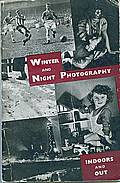 A 40 page booklet produced by Ilford
Ltd and dated August 1938 (H38 - illustrated courtesy of David
Muggleton) entitled 'Winter and Night Photography ~ Indoors and
Out'. Ilford used this booklet to appeal to amateur photographers
who might otherwise put their camera away from October to April,
expecting the winter light to be too dull for picture-making.
Ilford stressed that this reason was now made obsolete with the
introduction of Selo Hypersensitive Panchromatic roll film and
Hypersensitive Fine Grain Panchromatic (H.P.2) film for 35mm
users. In both cases the film speed had recently been increased
to H&D 3,500; 31° Scheiner (maybe 200ASA in modern terms).
A 40 page booklet produced by Ilford
Ltd and dated August 1938 (H38 - illustrated courtesy of David
Muggleton) entitled 'Winter and Night Photography ~ Indoors and
Out'. Ilford used this booklet to appeal to amateur photographers
who might otherwise put their camera away from October to April,
expecting the winter light to be too dull for picture-making.
Ilford stressed that this reason was now made obsolete with the
introduction of Selo Hypersensitive Panchromatic roll film and
Hypersensitive Fine Grain Panchromatic (H.P.2) film for 35mm
users. In both cases the film speed had recently been increased
to H&D 3,500; 31° Scheiner (maybe 200ASA in modern terms).
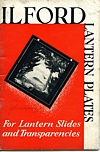 Booklet produced in June 1939 detailing
the production of Lantern Slides from negatives. "Of all
the fascinating bypaths of photography, it is doubtful whether
any gives such complete satisfaction and permanent pleasure as
the making and exhibition of lantern slides".
Booklet produced in June 1939 detailing
the production of Lantern Slides from negatives. "Of all
the fascinating bypaths of photography, it is doubtful whether
any gives such complete satisfaction and permanent pleasure as
the making and exhibition of lantern slides".
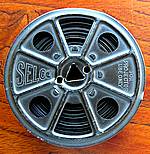 A 9.5mm metal cine film spool, clearly
embossed with the brand name SELO.
A 9.5mm metal cine film spool, clearly
embossed with the brand name SELO.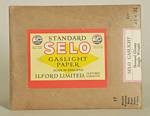


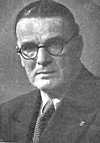 During the war years Ilford were proud
of their Lecture Team 'which carried on'.
During the war years Ilford were proud
of their Lecture Team 'which carried on'.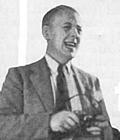 Another member of the Ilford lecture
team throughout the war and afterwards, was Henry G. Russell
A.R.P.S. F.R.S.A. Known as Harry to his family and friends. Anthony
(Tony) Russell, his son, provided me with this insight.
Another member of the Ilford lecture
team throughout the war and afterwards, was Henry G. Russell
A.R.P.S. F.R.S.A. Known as Harry to his family and friends. Anthony
(Tony) Russell, his son, provided me with this insight.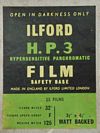


 An Ilford Limited letterhead, dated January
1944 (thanks to
An Ilford Limited letterhead, dated January
1944 (thanks to 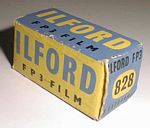
 6 exposure Selochrome film with an August
1946 expiry date.
6 exposure Selochrome film with an August
1946 expiry date. An
Ilford Selochrome print of the entrance to the newly opened HMP
Falfield, later to become Leyhill Prison in Tortworth Court,
between Gloucester and Bristol. It was taken by a (then) 10 year
old
An
Ilford Selochrome print of the entrance to the newly opened HMP
Falfield, later to become Leyhill Prison in Tortworth Court,
between Gloucester and Bristol. It was taken by a (then) 10 year
old 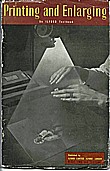
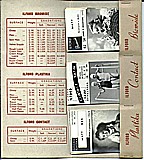
 A 42 page booklet, priced at 2s/6d (12.5p),
describing the use of Ilford contact and enlargement print materials
through all stages of their use including choice of developers,
print toning, presentation & choice of border and finally
titling the finished exhibition print. A footnote on the last
page shows PE/C.47, presumably meaning it was published in March
1947. The printers are Lund Humphries who give a number 18677.3.47,
which again indicates March 1947.
A 42 page booklet, priced at 2s/6d (12.5p),
describing the use of Ilford contact and enlargement print materials
through all stages of their use including choice of developers,
print toning, presentation & choice of border and finally
titling the finished exhibition print. A footnote on the last
page shows PE/C.47, presumably meaning it was published in March
1947. The printers are Lund Humphries who give a number 18677.3.47,
which again indicates March 1947._cr.jpg) My
thanks to Emma Fuell (
My
thanks to Emma Fuell (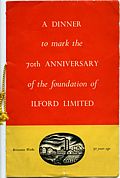
 General
release of
General
release of  Release
of the
Release
of the 
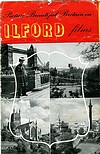 'Picture Beautiful Britain' leaflet describing
the Ilford Film range in the run up to the
'Picture Beautiful Britain' leaflet describing
the Ilford Film range in the run up to the  This
20 page booklet entitled Ilford Colour Films was published by
Ilford Limited, Ilford, London, around February 1952 (?, based
upon the rear cover printer's number ICF/B52/PLH). It describes
the principles of additive and subtractive colour processes and
determination of exposure under daylight & artificial light
for the 10ASA Ilford Colour Films type D and A.
This
20 page booklet entitled Ilford Colour Films was published by
Ilford Limited, Ilford, London, around February 1952 (?, based
upon the rear cover printer's number ICF/B52/PLH). It describes
the principles of additive and subtractive colour processes and
determination of exposure under daylight & artificial light
for the 10ASA Ilford Colour Films type D and A.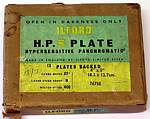
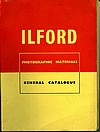
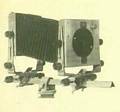
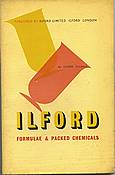
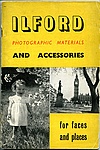 Booklet
similar to that shown in the 1955 'slot' (below) but unlike the
later booklet, this one is clearly identifiable as November 1953
by the normal Ilford dating system on the back cover (J53).
Booklet
similar to that shown in the 1955 'slot' (below) but unlike the
later booklet, this one is clearly identifiable as November 1953
by the normal Ilford dating system on the back cover (J53).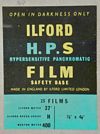

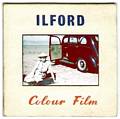
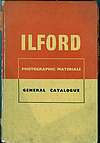 Ilford
Witness with f1.9 Super-Six lens, and E.R.Case, secondhand for
£70 at Sheffield Photo Co Ltd (Modern Camera Magazine;
June 1955).
Ilford
Witness with f1.9 Super-Six lens, and E.R.Case, secondhand for
£70 at Sheffield Photo Co Ltd (Modern Camera Magazine;
June 1955).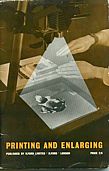
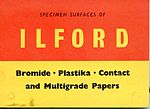
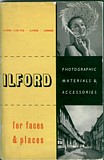
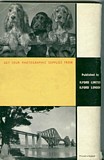 This
96 page 120mm x 185mm booklet entitled Ilford Photographic Materials
& Accessories 'for faces & places', is undated, but is
believed relates to late 1955 (maybe early 1956) as it predates
the release of Colour Film Type F in 1956, but post-dates the
release of HPS roll & 35mm film in 1954.
This
96 page 120mm x 185mm booklet entitled Ilford Photographic Materials
& Accessories 'for faces & places', is undated, but is
believed relates to late 1955 (maybe early 1956) as it predates
the release of Colour Film Type F in 1956, but post-dates the
release of HPS roll & 35mm film in 1954. Late
1956 saw the Introduction of Colour Film Type "F"
for use with clear flashbulbs. "...thus reducing the cost
of colour shots and saving the trouble of keeping two kinds of
flashbulbs" (i.e. blue for colour and clear for b&w).
Instructions are unclear and text suggesting "Twice the
speed of Ilford's Colour Film D", may simply mean twice
the speed compared to 'D' with a colour correcting filter on
the camera lens.
Late
1956 saw the Introduction of Colour Film Type "F"
for use with clear flashbulbs. "...thus reducing the cost
of colour shots and saving the trouble of keeping two kinds of
flashbulbs" (i.e. blue for colour and clear for b&w).
Instructions are unclear and text suggesting "Twice the
speed of Ilford's Colour Film D", may simply mean twice
the speed compared to 'D' with a colour correcting filter on
the camera lens.
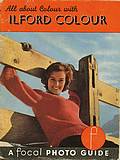 In 1959 the Focal Press Ltd (31, Fitzroy
Square, London, W.1) published this small (120mm x 160mm; 48
pages) booklet entitled "All about Colour with
ILFORD COLOUR". This is Focal Guide No.84, printed by Fletcher
& Sons Ltd, Harford Works, Norwich, UK.
In 1959 the Focal Press Ltd (31, Fitzroy
Square, London, W.1) published this small (120mm x 160mm; 48
pages) booklet entitled "All about Colour with
ILFORD COLOUR". This is Focal Guide No.84, printed by Fletcher
& Sons Ltd, Harford Works, Norwich, UK..jpg)
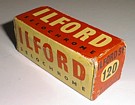 Ilford
Selochrome roll film only (orthochromatic) replaced by
Selochrome Panchromatic; no speed change. This film box is
a 120 roll of SP (Selochrome Panchromatic) 80ASA, 30ºBSI
& Scheiner, 20ºDIN film. It passed its expiry date in
June 1962. Post-1960, Selochrome Pan was re-rated at 160ASA (no
change in the emulsion). Maybe phased out around 1968 ?
Ilford
Selochrome roll film only (orthochromatic) replaced by
Selochrome Panchromatic; no speed change. This film box is
a 120 roll of SP (Selochrome Panchromatic) 80ASA, 30ºBSI
& Scheiner, 20ºDIN film. It passed its expiry date in
June 1962. Post-1960, Selochrome Pan was re-rated at 160ASA (no
change in the emulsion). Maybe phased out around 1968 ?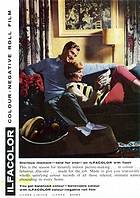 Following
further joint research with ICI, Ilford introduced
Following
further joint research with ICI, Ilford introduced  Ilfacolor (120/620 roll film only,
32 ASA = ISO) colour negative film, based upon an ICI patent.
Film cost 10/6d (52.5p). Processing (only by Ilford) was 6/6d
(32.5p). Enprints at 2/9d each (14p). It was a masked colour
material incorporating colour couplers immobilised by long-chain
hydrocarbon residues - Agfa type. The film was balanced for daylight
and artificial light, similar to the Kodacolor film at that time,
and the colour balance of the prints were then corrected on the
Ilford printing machines. Later, in 1961, Ilford introduced the
film in 35mm 20 exposure cassettes and they designed a special
printer to make colour contact strips from the 20 exposure films.
Ilfacolor (120/620 roll film only,
32 ASA = ISO) colour negative film, based upon an ICI patent.
Film cost 10/6d (52.5p). Processing (only by Ilford) was 6/6d
(32.5p). Enprints at 2/9d each (14p). It was a masked colour
material incorporating colour couplers immobilised by long-chain
hydrocarbon residues - Agfa type. The film was balanced for daylight
and artificial light, similar to the Kodacolor film at that time,
and the colour balance of the prints were then corrected on the
Ilford printing machines. Later, in 1961, Ilford introduced the
film in 35mm 20 exposure cassettes and they designed a special
printer to make colour contact strips from the 20 exposure films.
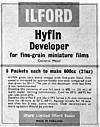
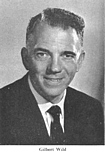 George
Dorman, who joined Ilford Ltd in 1922 and was advertising manager
from 1943 to 1961, relinquished his appointment to devote his
whole time, until retirement in 1963, to preparation of a revised
edition of "Positioning in Radiography", a respected
world-wide reference work.
George
Dorman, who joined Ilford Ltd in 1922 and was advertising manager
from 1943 to 1961, relinquished his appointment to devote his
whole time, until retirement in 1963, to preparation of a revised
edition of "Positioning in Radiography", a respected
world-wide reference work.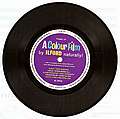
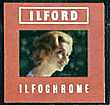 lford introduce their
32ASA Ilfochrome 32 colour reversal film, cost 28/6d for
a 36exp film or 19/6d for a 20 exposure (£1.43p & 98p
respectively), including postage and transparency mounting. It
was a non-substantive film, as was Kodachrome. To read about
Ilford's processing sequence for Ilfochrome,
lford introduce their
32ASA Ilfochrome 32 colour reversal film, cost 28/6d for
a 36exp film or 19/6d for a 20 exposure (£1.43p & 98p
respectively), including postage and transparency mounting. It
was a non-substantive film, as was Kodachrome. To read about
Ilford's processing sequence for Ilfochrome, 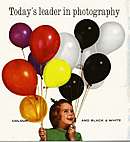
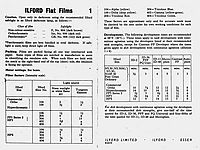
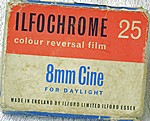
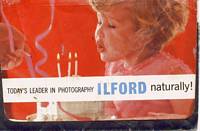
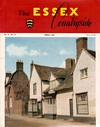
 20
page booklet on Ilford Formolith materials, made available by
David Muggleton. It is dated G63, hence July 1963.
20
page booklet on Ilford Formolith materials, made available by
David Muggleton. It is dated G63, hence July 1963.
 Illustrated
alongside is a 1502 Ilfoprint processor (see webpage
Illustrated
alongside is a 1502 Ilfoprint processor (see webpage 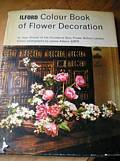 Produced
from 7th Sept 1964, the ILFORD "Colour Book of Flower
Decoration" was written by Joan Groves of the
Produced
from 7th Sept 1964, the ILFORD "Colour Book of Flower
Decoration" was written by Joan Groves of the 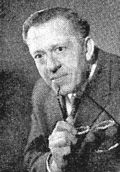
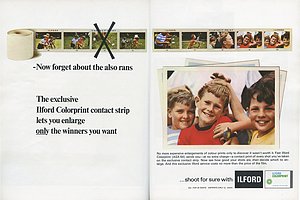
 In May 1965 Ilford introduced
a new negative 35mm 20 exposure film, 'Colorprint', rated
at 64 ASA, at a price inclusive of processing. At the same
time it discontinued production of Ilfocolor. The service whereby
35mm users received a projection printed (not truly 'contact';
see letter from Ilford's R.B.Matthews in Colour Photography magazine,
May 1963) contact print strip and card mounted negatives with
their processed film, continued, as it had previously with Ilfocolor
35mm. This service was advertised in AP magazine's Colour Numbers
(May & July) in 1966 using 2-page full colour spreads.
In May 1965 Ilford introduced
a new negative 35mm 20 exposure film, 'Colorprint', rated
at 64 ASA, at a price inclusive of processing. At the same
time it discontinued production of Ilfocolor. The service whereby
35mm users received a projection printed (not truly 'contact';
see letter from Ilford's R.B.Matthews in Colour Photography magazine,
May 1963) contact print strip and card mounted negatives with
their processed film, continued, as it had previously with Ilfocolor
35mm. This service was advertised in AP magazine's Colour Numbers
(May & July) in 1966 using 2-page full colour spreads.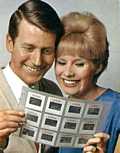
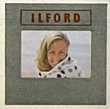 Also
in May, substantive reversal 35mm film introduced, called 35mm
Colorslide rated at 32ASA and 35mm Super Colorslide rated at
64ASA. Slides returned in a plastic pocket 'quick-look viewer'.
Iford explained "Now you can see just how good your shots
are the minute you get them!."
Also
in May, substantive reversal 35mm film introduced, called 35mm
Colorslide rated at 32ASA and 35mm Super Colorslide rated at
64ASA. Slides returned in a plastic pocket 'quick-look viewer'.
Iford explained "Now you can see just how good your shots
are the minute you get them!." 36exp Colorslide only 28/- (£1.40p)
and 20exp for 18/- (90p).
36exp Colorslide only 28/- (£1.40p)
and 20exp for 18/- (90p). My
thanks to Steve Slarke for donating "An ILFORD Colour
Book of Flower Identification ~ Rock Garden Plants" by Will
Ingwersen. Designed and produced by George Rainbird Limited and
printed by Jarrold & Sons Limited, Norwich. Copiously illustrated
with colour photographs, all taken on Ilfocolor film and
My
thanks to Steve Slarke for donating "An ILFORD Colour
Book of Flower Identification ~ Rock Garden Plants" by Will
Ingwersen. Designed and produced by George Rainbird Limited and
printed by Jarrold & Sons Limited, Norwich. Copiously illustrated
with colour photographs, all taken on Ilfocolor film and  Other
ILFORD Colour Books in this Flower Identification Series
are listed as "House Plants", "Cacti and Other
Succulents" and "Herbacious Plants 1".
Other
ILFORD Colour Books in this Flower Identification Series
are listed as "House Plants", "Cacti and Other
Succulents" and "Herbacious Plants 1".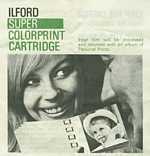 Ilford
film available for the first time in the 126 Instant (Instamatic)
cartridge system (
Ilford
film available for the first time in the 126 Instant (Instamatic)
cartridge system ( HP4
film became available in 35mm cassettes (roll film in 1965,
see entry above). Normal speed rating 400ASA, DIn 27 (or 650ASA
in Ilford's Microphen developer). Recommended prices 5s.10d (29p)
for 20 exposures and 7s.7d (38p) for 36 exposures. Also available
as cassette refills.
HP4
film became available in 35mm cassettes (roll film in 1965,
see entry above). Normal speed rating 400ASA, DIn 27 (or 650ASA
in Ilford's Microphen developer). Recommended prices 5s.10d (29p)
for 20 exposures and 7s.7d (38p) for 36 exposures. Also available
as cassette refills.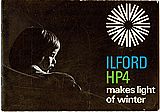
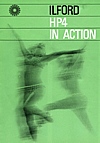
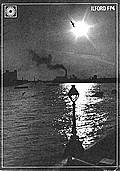
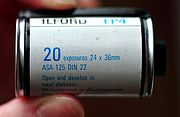
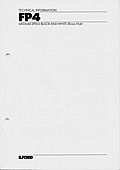
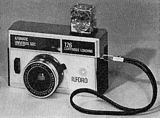
 Selochrome
roll film is understood to have been phased out in 1968, the
last film to bear the famous Selochrome brand, derived from the
1920s Selo factory name. Or was it? Information has come to me
from Alan Bendle (March 2008) who told me the pasing out
of Selochrome in 1968 was "True enough, but one of my first
jobs in 1969 was some testing on Selochrome 35mm film. I'm not
sure that this material ever found its way on to the market".
Selochrome
roll film is understood to have been phased out in 1968, the
last film to bear the famous Selochrome brand, derived from the
1920s Selo factory name. Or was it? Information has come to me
from Alan Bendle (March 2008) who told me the pasing out
of Selochrome in 1968 was "True enough, but one of my first
jobs in 1969 was some testing on Selochrome 35mm film. I'm not
sure that this material ever found its way on to the market".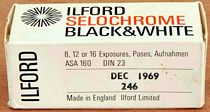
.jpg)
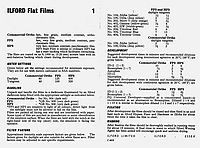
 Two
new film developers, tested in Amateur Photographer 21st January
1970; Ilfosol and Perceptol.
Two
new film developers, tested in Amateur Photographer 21st January
1970; Ilfosol and Perceptol.

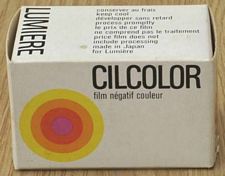 A
Cilcolor colour negative film, expiry date March 1979, is shown
alongside, courtesy of Michael Talbert. This carton is from a
36 exposure 35mm, speed 80ASA.
A
Cilcolor colour negative film, expiry date March 1979, is shown
alongside, courtesy of Michael Talbert. This carton is from a
36 exposure 35mm, speed 80ASA.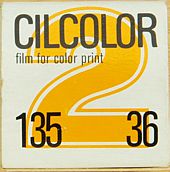
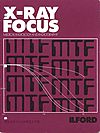 Bob Chaffee worked for Ilford Inc. in the US during 9years
from 1971 to 1979 and was involved in X-ray Medical Imaging.
Bob Chaffee worked for Ilford Inc. in the US during 9years
from 1971 to 1979 and was involved in X-ray Medical Imaging. Booklet published by Ilford for 1st January
1979 entitled:
Booklet published by Ilford for 1st January
1979 entitled: The
illustrated Guide describes the Ilford range of b&w films
(Pan F, FP4, HP5 & XP1 400) & recommends developers from
the Ilford range (Perceptol, Hyfin, ID-11, Ilfosol 11, Microphen;
also the special XP1 chemicals for the new chromogenic XP1 400
film).
The
illustrated Guide describes the Ilford range of b&w films
(Pan F, FP4, HP5 & XP1 400) & recommends developers from
the Ilford range (Perceptol, Hyfin, ID-11, Ilfosol 11, Microphen;
also the special XP1 chemicals for the new chromogenic XP1 400
film).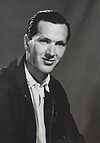
 Practical
Photography magazine for June 1984 carries a 2-page advert for
Ilfocolor HR colour print film, available in 35mm, 110
and Kodak disc formats. At this time, Ilfocolor colour print
film was named Ilfocolor HR and consisted of 100 and 200ASA speeds.
The picture alongside shows that it ultimately expanded to also
include 1000ASA 35mm. Meanwhile, the Fuji Photo Film Company
who made the (arguably market leading) Fuji HR colour print films
were amused (see Practical Photography for June 1984) to see
that the films from Ilford were similarly named 'HR'. Peter Samwell,
the Fujimex Divisional Manager stressed "While we don't
mind our competitors sharing a little of our limelight, we would
like to point out to customers that Ilford HR film, while being
manufactured in Japan, is not made by Fuji ..." Ilfocolor
HR seemingly didn't stay on the market beyond 1990 (?).
Practical
Photography magazine for June 1984 carries a 2-page advert for
Ilfocolor HR colour print film, available in 35mm, 110
and Kodak disc formats. At this time, Ilfocolor colour print
film was named Ilfocolor HR and consisted of 100 and 200ASA speeds.
The picture alongside shows that it ultimately expanded to also
include 1000ASA 35mm. Meanwhile, the Fuji Photo Film Company
who made the (arguably market leading) Fuji HR colour print films
were amused (see Practical Photography for June 1984) to see
that the films from Ilford were similarly named 'HR'. Peter Samwell,
the Fujimex Divisional Manager stressed "While we don't
mind our competitors sharing a little of our limelight, we would
like to point out to customers that Ilford HR film, while being
manufactured in Japan, is not made by Fuji ..." Ilfocolor
HR seemingly didn't stay on the market beyond 1990 (?).




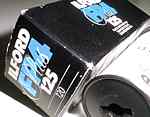
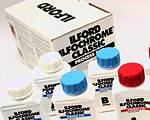 Cibachrome
name officially changed to Ilfochrome Classic at the PMA show,
Las Vegas.
Cibachrome
name officially changed to Ilfochrome Classic at the PMA show,
Las Vegas.  Ilford enter the
mass inkjet consumer market with the launch of the PRINTASIA
Inkjet Photo Range of papers.
Ilford enter the
mass inkjet consumer market with the launch of the PRINTASIA
Inkjet Photo Range of papers. On
9th March, the BJP website carried FURTHER GOOD NEWS:
On
9th March, the BJP website carried FURTHER GOOD NEWS: August, ILFORD Photo resumed shipment of ID-11
and Microphen powder monochrome film developers. ID-11 is supplied
in 1 litre and 5 litre packs, with Microphen in 1-litre packs.
Powder chemical manufacture at the UK site in Mobberley, Cheshire,
had ceased when Ilford Imaging went into receivership. Fact sheets
on the newly available ID-11 and Microphen obtainable by following
the links
August, ILFORD Photo resumed shipment of ID-11
and Microphen powder monochrome film developers. ID-11 is supplied
in 1 litre and 5 litre packs, with Microphen in 1-litre packs.
Powder chemical manufacture at the UK site in Mobberley, Cheshire,
had ceased when Ilford Imaging went into receivership. Fact sheets
on the newly available ID-11 and Microphen obtainable by following
the links 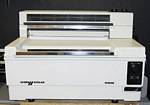
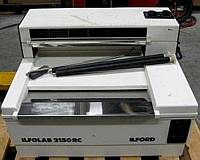 October
announcement of a limited number of the ILFORD 2150RC processors
(see picture) and ILFORD 1250RC dryers to be manufactured. The
ILFORD 2150RC tabletop processor outputs up to 460 8x10ins prints
per hour including automatic rinsing.
October
announcement of a limited number of the ILFORD 2150RC processors
(see picture) and ILFORD 1250RC dryers to be manufactured. The
ILFORD 2150RC tabletop processor outputs up to 460 8x10ins prints
per hour including automatic rinsing.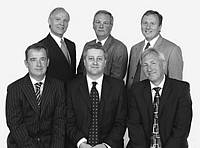 26Sept
- 1Oct at Photokina, primary position on the ILFORD Photo stand
is ILFORD GALERIE FB DIGITAL (a heavyweight 315g/m2 baryta
fibre-based paper) making its world debut. This is the only paper
in the world utilising ILFORD Photo's fibre base material which
can be exposed in digital laser printers, providing the opportunity
to create genuine silver gelatine prints from digital images.
26Sept
- 1Oct at Photokina, primary position on the ILFORD Photo stand
is ILFORD GALERIE FB DIGITAL (a heavyweight 315g/m2 baryta
fibre-based paper) making its world debut. This is the only paper
in the world utilising ILFORD Photo's fibre base material which
can be exposed in digital laser printers, providing the opportunity
to create genuine silver gelatine prints from digital images. December
2006, ILFORD Photo announced a new service to bring together
users and retailers of its products. Called Direct2Dealer (D2D)
the service is based on a catalogue of more than 380 products
available from ILFORD Photo.
December
2006, ILFORD Photo announced a new service to bring together
users and retailers of its products. Called Direct2Dealer (D2D)
the service is based on a catalogue of more than 380 products
available from ILFORD Photo.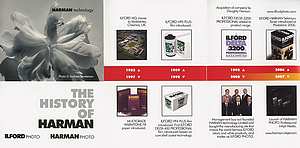
 'The
History of Harman' booklet with pull-out Harman timeline, as
given away at the 'Focus on Imaging' exhibition, NEC, Birmingham,
UK during February 2007.
'The
History of Harman' booklet with pull-out Harman timeline, as
given away at the 'Focus on Imaging' exhibition, NEC, Birmingham,
UK during February 2007.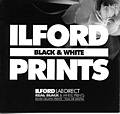 This small, free, 8 page leaflet, dated
February 2009 (B09), explains that 'ILFORD LAB DIRECT'
is a high quality, black & white photographic developing
and printing service, producing prints on Ilford silver gelatin
photographic paper from both film and digital files. Lab Direct
is both a mail order service and is also available '
This small, free, 8 page leaflet, dated
February 2009 (B09), explains that 'ILFORD LAB DIRECT'
is a high quality, black & white photographic developing
and printing service, producing prints on Ilford silver gelatin
photographic paper from both film and digital files. Lab Direct
is both a mail order service and is also available '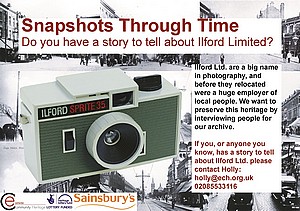 Eastside
Community Heritage have recently (February announcement) received
a £10,000 grant from the Heritage Lottery Fund to embark
on a project exploring the history of Ilford Limited.
Eastside
Community Heritage have recently (February announcement) received
a £10,000 grant from the Heritage Lottery Fund to embark
on a project exploring the history of Ilford Limited.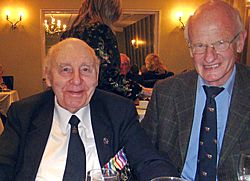 Although the connection
with Ilford is somewhat tenuous, this time 'slot' is dedicated
to the life of Leading Seaman Ronald W.W. Rendle JX167874, who
had an heroic and active career in the Royal Navy throughout
WW2. Despite being torpedoed twice, he survived the war and died
aged 98 on 23rd December 2017. His full naval story can be read
here:
Although the connection
with Ilford is somewhat tenuous, this time 'slot' is dedicated
to the life of Leading Seaman Ronald W.W. Rendle JX167874, who
had an heroic and active career in the Royal Navy throughout
WW2. Despite being torpedoed twice, he survived the war and died
aged 98 on 23rd December 2017. His full naval story can be read
here: